
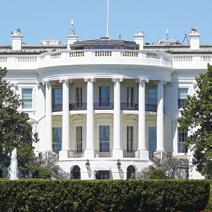



13 ENCOURAGING GROWTH IN GOVERNMENT AGENCIES 15 A MULTI-CLOUD APPROACH FOR INNOVATION 29 CIDC THOUGHT LEADERSHIP COMPENDIUM ALSO INSIDE: Q4 2022 PSC: Celebrating 50 Years of Serving the Government Contracting Industry

Pheniece Jones jones@pscouncil.org
PSC STAFF
David J. Berteau
President & CEO berteau@pscouncil.org
Stephanie Kostro
Executive Vice President, Policy kostro@pscouncil.org
David Broome Executive Vice President, Government Relations broome@pscouncil.org
Cate Benedetti Vice President, Government Relations benedetti@pscouncil.org
Joe Carden, CAE
Senior Vice President, Marketing & Membership carden@pscouncil.org
Paul Foldi Vice President, International Development foldi@pscouncil.org
Melissa R. Phillips, CMP Director, Operations phillips@pscouncil.org
Robert Piening, CPA, CGMA Vice President, Accounting & Finance piening@pscouncil.org
Matthew Busby
Director, Membership busby@pscouncil.org
Michelle Jobse
Director, Vision Forecast jobse@pscouncil.org

Cassie Katz Director, Marketing katz@pscouncil.org
Andrea Ostrander Vice President, Events ostrander@pscouncil.org
Pheniece Jones Director, Media Relations jones@pscouncil.org
Jean Tarascio
Director, Events tarascio@pscouncil.org
Donald Baumgart Manager, Vision Forecast baumgart@pscouncil.org
Karen Holmes Office Manager holmes@pscouncil.org
Christian Larsen
Senior Associate, Public Policy larsen@pscouncil.org

Sebastian Herrick
Senior Associate, Public Policy herrick@pscouncil.org


James Millar Associate, Research millar@pscouncil.org

Natalia Gray Associate, Events gray@pscouncil.org
Laila Hammonds Associate, Membership lhammonds@pscouncil.org
Daniel Boddie Associate, Digital Marketing boddie@pscouncil.org
Professional Services Council Service Contractor / 2022 / 3 29
15
CIDC THOUGHT LEADERSHIP COMPENDIUM
CAN A MULTI-CLOUD APPROACH SPUR THE RIGHT KIND OF INNOVATION Cover montage by Studio25 using images from shutterstock.com/4kclips/Erika Cross/Studio Melange/Aerial Mike
Service Contractor is a publication of the Professional Services Council 4401 Wilson Blvd., Suite 1110 Arlington, VA 22203 Phone: 703-875-8059 Fax: 703-875-8922 Web: www.pscouncil.org All Rights Reserved For advertising or to submit articles or items for the Member News section, contact:
ENCOURAGING GROWTH IN GOVERNMENT AGENCIES 13 5 PSC Celebrates 50 YEARS and the Future Focus 4 President’s Letter 17 Bill Tracker 28 Member News Q4 2022
PRESIDENT’S LETTER
Welcome to this very special edition of Service Contractor, commemorating 50 years of PSC. As we look back on 2022, it somehow seems fitting that the year had both challenges and surprises for government contractors. PSC worked with our members and industry to address delays in many areas: in Congress providing funds, in agencies obligating those funds, in awarding contracts on schedule, and in finding and keeping enough great workers. One area where there was no delay was in the rising cost of inflation.
Through it all, PSC continued to meet and collaborate with many federal agencies, including quarterly meetings with each of the FAR council principals (GSA, NASA, DoD, and the Office of Federal Procurement Policy in the White House). We submitted dozens of formal comments on proposed rules and pending regulations, and some of those comments had real impact. We worked closely with Congress to support good ideas and resist bad ones. The PSC bill tracker in this magazine highlights the status and major actions of key bills on the Hill.
This year also saw a return to in-person PSC conferences. The PSC Annual Conference and our half-day conferences were all widely attended with great government speakers and content. Coming events in 2023 will let us gather, network, and find solutions to the industry’s challenges.
For 50 years, PSC has been serving the government contractor industry, advocating for contractors, improving industrygovernment relations, and bettering the process of doing business with the government. In the feature article of this issue, I invite
you to join me in a little journey down memory lane to show where we’ve been and all of the important work remaining.
2023 brings divided government with Republicans and Democrats split in Congress. This is not rare; for nearly 30 of the past 42 years, PSC will urge the White House and agencies to focus on implementation and execution of existing programs through using available funds to improve government through better, more timely contracts. The funding is there, the work needs to be done. Their best hope to move forward is to solicit, evaluate, award, and let you perform.
We will continue to be the voice of reason on the Hill, with the agencies, and in the news media. We will continue to communicate all of that to you and with you.
Here is our promise to you. You have a great team at PSC, working for you and with you. We aim to be your best advocate against these challenges and surprises. With your support and engagement on the issues and possible solutions, we will continue to see some real successes.
In closing, it is such a privilege working on behalf of this industry. The future of America depends on a government that we can trust, a government that performs better, and the best way to have that is to take better advantage of all that government contractors have to offer. We will continue every day to help you make that happen.
We wish you and yours a healthy and prosperous new year in 2023.
David J. Berteau, President and CEO

4 / Service Contractor / 2022 Professional Services Council
PSC 50 Years and the Future Focus

When PSC began 50 years ago, our sector was largely unknown as part of US economy. Half a century later, PSC has helped make our industry one of the most prominent and high impact forces affecting the lives of Americans across the entire federal government.

shutterstock.com/SeventyFour Professional Services Council Service Contractor / 2022 / 5
inset photo:
The Birth of the Organization
In the late 1960s, Dr. Robert Krueger (then CEO of the government services contractor PRC) undertook research into companies doing work similar in nature to PRC, adopting the term ”professional services.” The study identified 1500 professional services firms in an industry that was growing at twice the rate of the rest of the economy.
Krueger realized that one value of the research was identifying possible allies to join with PRD in battling common problems. To this end, in 1970, Kruger wrote to some of those companies on two issues: the government’s tendency to bring in-house work that could be done well by private-sector for-profit companies and the preferential treatment given to nonprofit organizations, particularly Federally Funded Research and Development Centers (FFRDCs). More than half of the contacted organizations joined together to address these issues.
The new business allies began visiting Capitol Hill and members of the executive branch to further their causes of full and open competition and using contractors to improve government operations and performance. In 1972, the group incorporated as The National Council of Professional Services Firms in Free Enterprise (NCPSF), operating from PRC offices.


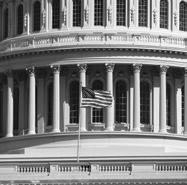
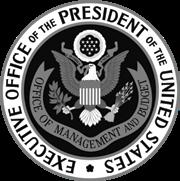
The Early Years
NCPSF took on both challenges. One early success led to an update of the Office of Management and Budget’s Circular A-76, the rules to be followed by the government before a decision can be made to keep work in-house.
The Council released a white paper to set forth its free market convictions, but sole-source contracts continued to be awarded to FFRDCs and other non-profit organizations. Council members felt strongly that they should be afforded the chance to compete on these contracts.
More broadly, procurement improvements were slow in the early 1970s. Through eight annual reports beginning in 1972, GAO (then named the General Accounting Office) offered recommendations from the congressionally-created Commission on Government Procurement Reform. GAO’s1979 final report noted that work on Commission recommendations was “far from complete, and momentum was slowing.”
The absence of top government attention to procurement, coupled with the fact that the Council had no paid staff and relied on contributions from a handful of firms to cover operating expenses, constrained success in the early years.
Early Successes
The mid 1970’s brought increased visibility to services contracts. The creation of the Office of Federal Procurement Policy (OFPP) opened possibilities for additional advocacy by the Council. One important achievement of this era was the rejection of the FEDNET proposal for a massive interlocking internal government data processing system that would have needlessly duplicated capability available from the private sector.
Advocacy Delivers
By the late 1970’s, NCPSF garnered increased attention and visibility for the industry through efforts led by BDM International’s CEO, Earle Williams. As more federal agencies pursued improved

6 / Service Contractor / 2022 Professional Services Council
H.R. 7674
performance at less cost through well-structured, competitive contracts with the private sector, Council member companies were expanding their focus to become government-wide.
One of the Council’s biggest accomplishments during the Williams era was the rejection of a labor union/IEEE-sponsored amendment to the Services Contract Act under which the U.S. Labor Department would set wages for all professional employees working on government contracts instead of using competition and private sector expertise to offer the best value for the government.

Industry-Killing “Reform”
The decade of the 1980s ushered in an era of change for the Council. A new charter changed the somewhat unwieldy name from the National Council of Professional Services Firms in Free Enterprise to the Professional Services Council. The Council appointed the Council’s first executive director, Virginia Littlejohn. Under her leadership, PSC’s reach expanded as the issues grew.
PSC faced a serious challenge, the proposed Consultant Reform Act of 1980. Introduced simultaneously in the House and Senate, this bill would have virtually eliminated the professional services contracting industry by requiring prior notice to Congress of every contract above $10,000 and forcing agencies to submit quarterly reports with the name and hours worked of every services contract worker.
The work of the Council helped ensure that the bill never came to a vote. It also focused PSC member attention on the lack of understanding in Congress and federal agencies of the need for and the real benefits of well-structured contracts and a fair and open procurement process. Today, enhancing that understanding remains a priority of PSC.
A New Administration Moves Forward
The Reagan administration from the beginning in 1981 sought to increase federal agency access to the talent and skill of the services contractor community. Its renewed focus on public-private competition under OMB Circular A-76 led to a dramatic increase of such actions.
PSC urged a level playing field, though the rules for such competitions strongly favored the government. For example, industry proposals needed to save more than 10 per cent over government costs, which did not include the same indirect costs and overhead burden as required in industry bids. Nevertheless, industry won roughly one third of all A-76 competitions.
Through these and numerous other actions focused on a fair marketplace and open competition, PSC expanded its voice and strengthened its advocacy on behalf of its growing membership.


Star Wars and Ross Perot
As programs, requirements, and funding grew for technical and professional services from contractors, PSC expanded its efforts. In the mid 1980’s, PSC reached its most visible FFRDC victory to date. The newly formed Strategic Defense Initiative sought to create a 500 person FFRDC to perform technical and management services. The need for speedy action and clear results helped as PSC fought vigorously against this plan. Through its efforts, the initiative was never proposed to Congress.
Also in the 1980s, faced with defense funding shortfalls late in the fiscal year, Deputy Secretary of Defense William Taft issued a freeze
Professional Services Council Service Contractor / 2022 / 7 continued pg. 8
H.R. 1670
on funds that supported all contract spending on services. This freeze remained in place until concerted industry efforts led to congressional action that addressed the shortfall and ended the freeze.
Sometimes the threats to the industry came not from Congress or federal agencies, but from other companies. For example, Perot Systems proposed a major sole-source contract with the United States Postal Service, a blatant abuse of fair and open competition. The Council and its members were unified and, faced with resistance from the entire industry, Perot Systems backed down.
As the industry grew, PSC played a key role in forming and sustaining broad coalitions of trade associations organized to promote open access to government markets and to deal with specific A-76 type issues.

“87 in 87”
One of the most significant industry victories of the decade came in 1987 with the creation and implementation of Standard Industrial Code (SIC) 87 for “Engineering, Accounting, Research, Management and Related Services”. PSC single-handedly worked with the Labor Department to develop and promote this category, formalizing the sector and its contribution to the United States economy.
“87 in ‘87!” became the rallying call for PSC. The new SIC legitimized professional services as far more than consultants and represented both a symbolic and substantive success.
The industry itself could visibly stand on its own. At the same time, PSC was becoming more visible as well. By the late 1980s, under President Mark Schultz, PSC became a free-standing organization, with its own office, full time director and staff. Its new-found capability would soon be needed.

The Acquisition Reform Era
Criticisms of and improvement efforts for the federal procurement system are as old as the nation itself. From the beginning in 1972, PSC has worked to have the government not only admit problems but do something about them. Opportunities for real reform seldom arise, but when they do, PSC has been ready.
Bert Concklin became PSC’s first president in 1990, just in time to lead PSC through a very productive decade.

With PSC’s strong support, the administration of President George H. W. Bush focused on better implementing ongoing initiatives, from the Packard Commission’s recommendations on acquisition reform to the SemaTech program to strengthen America’s semiconductor industry.
In 1993, President Clinton’s administration began with a commitment to “re-inventing” government. The new Administration focused on public-private sector partnerships, a commitment to exploiting the power of information technology, and a candid recognition that the federal acquisition system was in need of reform.
PSC began immediately to work with the Administration and its first OFPP Administrator, Steven Kelman, to achieve mutual objectives in promoting and supporting acquisition reform initiatives in the administration’s 1993 National Performance Review.
PSC also played a significant role in two major legislative triumphs that remain in force today.
The first, the Federal Acquisition Streamlining Act of 1995 (FASA), focused on best value contracting, eliminated duplicative statutes, and increased the potential use of commercial products and services and including a best-value policy. PSC’s role led to being invited to the Rose Garden Ceremony where the Act was signed.
8 / Service Contractor / 2022 Professional Services Council
The second, the Federal Acquisition Reform Act of 1996 (FARA), required government-wide Information Technology reform.

PSC had become a major player in federal acquisition reform efforts. Together, the new legislation and the performance review recommendations opened new methods of procurement and access to the skills and capabilities of PSC member companies and all federal private sector contractors. Task order contracts and blanket purchasing agreements enabled agencies to move from requirements to contracts in weeks instead of years. PSC worked with agencies to create and make good use of these innovative contract vehicles, often providing input both to draft solicitations for the master contract as well as helping share best practices among agencies.
One such contract supported by PSC was the Army’s Logistics Civil Augmentation Program contract (known as LOGCAP). When U.S. military and allied forces deployed to the Balkans in the mid-1990s, LOGCAP enabled rapid delivery of results. This showed the way for more rapid acquisition and more effective results not just for defense but for all federal agencies across the spectrum of missions and functions.
The 1990s saw action in privatization of operations and functions that were previously government owned and operated. The Defense Department’s base closure process led to contracts to deliver technical and logistics services at closed bases from Indiana to Texas and California. PSC supported these actions, and PSC member companies contributed significantly to a process that enabled DoD to retain capability, save billions of dollars, and support a more diverse and resilient economy.
Beyond DoD, PSC supported studies and actions that reduced unneeded federal direct competition with the private sector, contradicting existing guidance and long-standing practice.

These dramatic post-Cold War initiatives and changes were supported and fostered by PSC from concept to fruition. They enabled government agencies to cut costs and save money, access systems and processes that were new and innovative, and deliver better results faster
PSC: 1997-2015
PSC was founded toward the end of the Vietnam War, grew and changed over decades of the Cold War, and matured following the collapse of the Soviet Union. Those were seen as momentous times, but the dawn of the 21st century were even more dramatic. PSC and the government contracting industry have participated actively in changes that have been transformative for our government, the nation, and the entire world. Here are some of the events and forces that have shaped, and continue to shape, the marketplace in which PSC members operate today.
PSC selected as its next president Stan Soloway, who had been one of the architects of many of those reforms during his time in the Pentagon during the Clinton administration. He was still in his first year leading PSC when the world turned upside down in one brief hour.

9/11
The terrorist attacks of September 11, 2001, changed everything, everywhere. Creating the Department of Homeland Security was the most significant government reorganization in a half-century. America undertook two major conflicts and worked to prepare for and guard against domestic threats. To meet all of these emerging needs, government contractors provided the surge capacity, flexibility, innovation, and technology the government needed. Congress
continued pg.10 Professional Services Council Service Contractor / 2022 / 9
appropriated the necessary funding, including robust supplemental appropriations. The acquisition reforms of the 1990s opened new avenues of collaboration between the public and private sectors.
The demands of two wars required unprecedented levels of contractor support around the world, including development and reconstruction efforts simultaneously underway. Limited military protection meant an equally unprecedented need for private security for contractors themselves as well as for deployed personnel, including federal civilian employees,. PSC engaged and provided industry leadership on a broad array of issues from logistics and liability to prices and protests.

PSC worked with top levels of the Executive Branch, Congress, and the media, to ensure that the concerns and realities that member companies faced were widely considered and protected. Often, PSC was defending the government itself, for example at congressional hearings at which contracting officers and officials were targets. In addition, PSC partnered on “lessons learned” studies and testified before the Commission on Wartime Contracting and the Gansler Commission.

Many of the issues then are still on the PSC agenda today: resultsoriented contracting, workforce challenges and costs, risk aversion, and more. As these issues grew, PSC membership grew with them, from fewer than 90 member companies in the late 1990s to more than 200 following the merger of PSC with the Contract Services Association.

Convergence of Technology and Professional Services


Other changes in services contracting were also underway. The definition of “services” contracting has changed dramatically in the past two decades. What the government once procured as a product can now be contracted “as-a-service.” Many companies thrive at the crossroads of technology and services. The market itself, for both buyers and sellers, has changed.
PSC changed with the market, adding staff and developing a broader structure and advocacy approach. Effectively, PSC created five operating councils, two in the core policy arenas of acquisition policy and technology and three customer-facing councils for Defense, Civilian, and International Development agencies. PSC members could now engage and provide leadership in the areas that most affected their business.
This broader approach also provided government officials with clear lines of communication with the association, expanding PSC’s collaboration with government at all levels and on a wide array of issues and challenges. The final step of this new model was the 2015 acquisition of Tech America’s Vision Federal Market Forecast research and conference.
Conflicting Policy Goals
Changes in federal contracting, whether driven by two long wars, innovation, funding issues, or evolving requirements, have combined over the past 20 years to create competing and conflicting policy goals. These incompatible goals created and sustained an environment in which certainty and stability have been largely absent for the industry and its government customers.
Such incompatible goals range from the desire to attract new companies to the federal market while issuing ever-growing compliance requirements and from awarding contracts based largely on the lowest price to demanding the highest caliber of contractor personnel. PSC’s members have had to navigate a sometimes wildly inconsistent market.
PSC has responded to these conflicting goals as the single leading voice of industry on acquisition issues. In the 1990s, PSC President

istockphoto.com 10 / Service Contractor / 2022 Professional Services Council
Bert Concklin led PSC members in developing both FASA and FARA, as well as major agency initiatives such as the FAA’s Blue Ribbon acquisition reform effort. Concklin’s successor, Stan Soloway, and PSC’s first executive vice president, Alan Chvotkin, were active, visible players on the full range of policy issues with Congress, in the agencies and the White House, and across the news media.
The Workforce Question
For more than 50 years, one of the central questions in federal government contracting has been whether work should be performed by government civilian employees (in-house) or by contractors.

This debate is complicated by the fact that the federal government uses the procurement process to advance goals beyond performing the core tasks of the contract. Issues of trust, equity, social benefits, etc., lead to compliance requirements levied on government contractors that are different from and harder than those imposed on the general economy. Often, contractors have to meet requirements (such as accurately tracking and recording every work hour) that are not imposed on government personnel.
It is also hard to compare costs. Federal contractors must, by law and regulation, reveal fully burdened cost for contracts. As a PSCfunded study by the think tank CSIS concluded in 2010, there is no equivalent accounting for or allocation of government costs. Being unable to compare costs makes it harder to determine the more effective or efficient option.
In recent years, however, attention has focused less on insourcing and more on a blended workforce of government and contractor personnel. The question is, who can hire, train, and retain the workforce needed to do the work.
In part, that is because of the massive talent gap between the public and private sectors. Government services contractors are public servants; they are as committed to the mission as their government counterparts. However, talented people are not pursuing public service in sufficient numbers to meet today’s needs, much less replace the aging federal workforce.

On this issue as in so many others, PSC’s leadership has been both crucial and unique, pointing out solutions to the many ways in which the federal government undermines contractor access to talented workers with long delays in contract solicitation and awards, restrictive labor category requirements, and evaluation criteria that put a premium on lowest cost.
PSC: WHERE WE ARE AND WHAT’S AHEAD

After 15 years as PSC’s president and first CEO, Stan Soloway stepped away. He was succeeded by David Berteau in early 2016. Like Soloway, Berteau came from government, where he had been the Assistant Secretary of Defense for Logistics and Materiel Readiness. Federal budgets and contract obligations had been declining under the Budget Control Act caps on both defense and civilian agencies. Military forces in Iraq and Afghanistan were declining, and new government initiatives were on hold as the Obama administration was in its final year and the 2016 presidential election was well under way.

Budget Growth
That 2016 election put President Trump in the White House. Within six months, Congress had raised the sequester caps in the first
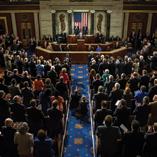
continued pg.12 shutterstock.com/Drop of Light Professional Services Council Service Contractor / 2022 / 11
of three increases that added more than 30 per cent to defense and civilian agency appropriations by FY 2021.
Contract obligations also rose, though by smaller percentages than the budget, as appropriations bills were late nearly every year, despite PSC’s urging Congress to enact on-time appropriations for the full fiscal year, This left agencies little time to execute funds.
This pattern continued, leading in late 2018 to a 35-day partial government shutdown, the longest in U.S. history. Throughout, PSC was at the forefront, pushing Congress and the White House to appropriate funds and advising companies on actions that had never been needed before. Through nearly 1,000 media citations. PSC used the media to amplify the negative and unnecessary impacts. PSC’s Shutdown Resource Center remains today’s go-to source for information for PSC’s members.
Recent PSC Initiatives and Success
PSC is tackling some of the most persistent issues facing government contractors today. Here are some recent and ongoing initiatives and successes.
• PSC was instrumental in the efforts by OPM and DoD to reduce security clearance backlogs from 700,000 to 200,000, and we continue to work on remaining problems.
• Legislation supported by PSC requires all federal agencies to define and measure PALT, Procurement Administrative Lead Time. Early results prove what every PSC member knows – the government is taking longer to award contracts. Measuring this is the first step in reducing it.
• Cybersecurity threats grow faster than standards and regulations evolve. PSC has been instrumental in representing industry as DoD and other agencies set cybersecurity requirements for contractors.

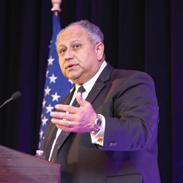
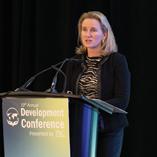

• Vaccine mandates that were imposed on contractors are on hold, pending court actions. PSC continues to urge the White House to adopt an approach that balances the health of the contractor workforce with the ability to deliver on contracts.
• Presidential Executive Orders continue to add new priorities to regulations and contracts. PSC actively comments on proposed and interim rules and follows up with frequent, high-level communications on those comments. Where needed, PSC pursues legislation to temper the burden these new priorities impose on contractors, often without reimbursement of increased costs.
PSC calls it like it is. When DoD’s competition report claimed too little competition in contracts, PSC countered with data and public commentary.
What’s Next
2023 will see a divided Congress that is likely to reduce new legislation and could potentially lead to a government shutdown at the end of the fiscal year. With Congress, PSC will advocate for on time appropriations and avoiding a shutdown. With the White House and federal agencies, PSC will be urging the administration to focus on the implementation and execution of existing programs. There is plenty of work to be done, funding to support it, and contractors ready to bid and perform. As it always has, PSC will advocate for that fair and competitive contracting environment, because we know that our member companies will thrive under those conditions.
The PSC staff are proud and honored to represent the hundreds of companies who support PSC. We look back at our past efforts and forward to supporting our industry for the next 50 years. 3
shutterstock.com/SeventyFour 12 / Service Contractor / 2022 Professional Services Council
The Pathway To Mid-Sized Company Status Is Complicated.
Here’s What The Government Can Do To Encourage Growth.
by David J. Berteau, President and CEO and Sebastian Herrick, Senior Associate, Public Policy, The Professional Services Council


Growth is a fundamental driver of the American business model. Often seen as a reward for hard work and skill, the goal of growth encourages businesses to use resources and experience to make further inroads in the marketplace. As a result, customers benefit from a full spectrum of product and service solutions to support mission success.

Policies and programs in government contracting, however, do not always reward growth. Federal policies that aim to encourage business growth for some companies can also impose middle-market pressures that stultify (or even reverse) growth for others. These policies may penalize businesses for doing well. A Government Accountability Office analysis shows that only 22 percent of federal contractors that grow beyond the U.S. government’s small business size classifications flourish and remain mid-sized companies. Only three percent grow further into large companies. Most businesses that work hard and move out of small business status will either be acquired by another business, revert back to being small, or leave federal contracting entirely.
For those businesses that want to remain small or may seek only to be acquired, this information is not disheartening.
However, most companies are in the federal contracting business because they care deeply about the missions of their government agency customers. They want to remain viable as a mid-sized company and continue to support those missions. For them, it’s a different story.
At PSC, we believe government policies should support business growth, not simply ignore companies that outgrow their small size status.
In addition, such policies would support the goal of nearly every administration to increase competition and encourage new entrants into federal business. What would supportive government policies look like? Here are three challenges facing mid-sized government contractors. Our proposed solutions
could serve to promote more competitive federal contracting, encourage innovation, and support long-term investments in mid-sized business.
The federal government recognizes only two categories of businesses. “small” and “other than small.” Small businesses justifiably receive competitive benefits as a result of this classification, but “other than small” businesses do not. The Small Business Administration (SBA) determines a size standards that, omce exceeded, mean that SBA no longer tracks companies or monitors their progress. The first challenge, therefore, is that the government does not have data on mid-sized companies, companies that once were “small” but no longer are.
Professional Services Council Service Contractor / 2022 / 13
continued pg.14 istockphoto.com
The solution is to promulgate a common definition of “midsized companies and to collect data on whether pro-growth program objectives are being met. For example, mid-sized companies could be those between upper limit of NAICS code size standards and a ten-times multiplier for the prevailing SBA size standard—at the time of this writing, $415 million or 15,000 employees. This would ensure data collection and future policy considerations would capture high-performing outliers and all small businesses that are no longer eligible under their respective size standards.
The second challenge is that set-aside contracts have sometimes increased in value such that a single contract or task order can and often does catapult a small business beyond its size standard. These businesses must then face full and open competitions with larger companies or take actions to revert back to “small” (e.g., by selling components to maintain small size status).
A solution would be for the federal government to consider revisiting the method for assessment of size standards. For example, companies could average the lowest three of the last five years of revenue or allow companies to address average inequity by choosing the best calculation for them – three years versus five years.
In addition, the government could assess the impact of such high-value set-aside contracts for their impact on the future eligibility of small businesses.

The third challenge is that the increased use of “self-scoring” in task-order level competition, under which companies report on the number, size, and types of contracts performed. While large businesses may have many examples of allowable past performance, mid-sized companies may not, putting them at a competitive disadvantage despite having sufficient capability and capacity to perform well if selected.
One solution would be for federal agencies to reduce quantitative past performance measures and increase consideration of past performance through qualitative experience. Specifically, agencies could consider experience and skills of both prime contractors and significant subcontractors, which could broaden the competitiveness of mid-sized contractor experience in source selection.
The American economy rewards growth in almost every other industry and sector. Success is worth celebrating. Growth is worth encouraging. Taken together, these three possible solutions of a common definition of mid-sized companies, a review of size standard assessments, and the incorporation of qualitative elements in source selection could support growth for midsized companies while also enabling the government to reap the benefits of small business policies and programs by supporting those that are successful. 3
14 / Service Contractor / 2022 Professional Services Council
shutterstock.com/LALAKA
Can A Multi-Cloud Approach Spur the Right Kind of Innovation for the Federal Government?
by Christian Larsen, Senior Associate, Public Policy, PSC

For the last two decades, the federal government has moved steadily toward procuring cloud computing capabilities from the commercial sector. First, the Federal Information Security Management Act of 2002 (FISMA) and 2011’s Federal Risk and Authorization Management Program (FedRAMP) laid out security requirements for federal contractors. More recently, the transition from broad authority in its legacy Federal Cloud Computing Strategy (Cloud First) to a Cloud Smart approach with more practical implementation guidance has supported the federal government’s aim to drive cloud adoption across the agencies.1 Concurrently, the commercial sector has evolved its offerings to federal clients, with notable cloud service providers (CSPs) supporting and managing cloud ecosystems for several federal agencies.
Because emergent and evolutionary technology development often outpaces federal contracting requirements, government officials tend to favor approaches that allow them access to multiple vendors with an assortment of capabilities and solutions in support of agency needs. One good example is a multi-cloud approach or architecture in which the federal government can use the same or similar cloud services from a variety of CSPs.2 And as more federal agencies move in this direction, complexities will continue to abound in contract management, including but not limited to licensing and integration issues, security requirement standardization, and ways in which vendors are assessed for task orders.
The U.S. executive branch spends billions of dollars in cloud computing capabilities, even as the U.S. Congress continues to debate the cost-saving efficacy of cloud services. Common questions for industry include: Is a multi-cloud approach the best strategy to spur innovation from the commercial sector? Does it deliver on its promises? Does it actually create open competition?
As part of this discussion, some experts argue that the federal government could access more innovation and innovative solutions from the commercial sector through multi-cloud approaches in IT-driven procurements— particularly companies operating outside the traditional defense industrial base. However, before that potential can be realized, there must be a general understanding of the benefits and challenges of utilizing multi-cloud, as well as what steps
the federal government must take to fully leverage the breadth of America’s innovation ecosystem.
PRO: A multi-cloud approach is ideal for the Government and companies in the commercial sector
As cloud is increasingly becoming the standard method to support IT infrastructure needs in both the public and private sectors, proponents of a multi-cloud approach first note that this type of procurement offers more choice to federal customers. By extension, this can lead to more options in support of critical mission needs. As requirements change, they note, multiple vendors can respond to those changes at the task order level. This can ultimately drive innovation to the end-user and reduce costs to the American taxpayer.
Second, while vendors must adhere to specific security requirements based on the classification and type of work performed, having multiple vendors on a contract vehicle with similar yet distinct security architectures can potentially prevent attacks.

Third, and probably the most controversial argument for a multi-cloud approach, is that this approach avoids vendor lock-in. While the market for full-fledged CSPs is quite small,
1 Federal Cloud Computing Strategy. Retrieved from https://cloud.cio.gov/#:~:text=From%20Cloud%20First%20to%20 Cloud,safe%20and%20secure%20cloud%20infrastructure.
2 Multi-Cloud and Hybrid Cloud Guide. (2021, September 3). General Services Administration. Retrieved from https://www.cio. gov/assets/resources/Multi-Cloud%20and%20Hybrid%20Cloud%20Guide_v4_Final.pdf
Professional Services Council Service Contractor / 2022 / 15
continued pg.16 shutterstock.com/Gorodenkoff
inviting smaller, more diverse, and non-traditional IT and cloud vendors to perform work at the task order level would help spread workloads and could reduce costs.
Finally, using a multi-cloud approach with multiple vendors can reduce the risk of post-award protests, particularly at the task order level within a more traditional multi-vendor Indefinite Delivery, Indefinite Quantity (IDIQ) contract. The end result is that a multi-cloud approach actually creates a fairer market for companies to compete in, which supports America’s global competitiveness.
CON: A multi-cloud approach is not ideal for the Government and companies in the commercial sector
First, some experts argue that even if a multi-cloud approach to specific, complex procurements is beneficial, individual companies can provide multi-cloud solutions without being on contract with other CSPs. Also, by putting multiple vendors in a multi-cloud ecosystem, the federal government may view vendors equally in solutions they provide at the task order level. Potentially, this could augment the prospect of increased protests as vendors compete for the same work while arguing that their competitors’ capabilities are insufficient.
Second, there is still a chance of vendor lock-in, some experts note, as licensing fees and related costs will remain an issue. Also, at issue are costs of integration between different vendors and the types of systems. It is likely, too, that government clients
will only use familiar vendors, leaving little to no room for more diverse companies to compete for space on a given contract.
Third, even if multi-cloud procurements are effective in delivering more innovation to the end-user while supporting an agency’s missions, program offices may still have structures and processes that hinder certain vendors; also, at issue may be how a contracting officer will solicit or assess proposals. For a multi-cloud procurement to be effective, a contracting officer must understand how to manage a multi-cloud environment with multiple service providers.
Conclusion
While there are benefits and challenges to a multi-cloud approach, the federal government needs to harness the totality of companies that can drive innovation with their unique sets of capabilities and solutions. For too long, the federal government has concentrated considerable focus on traditional IT vendors, leaving non-traditional companies wondering if there was a business incentive to work on federal contracts. A multi-cloud approach could increase competition in the federal marketplace and provide program offices with more options that, if managed well, could drive innovation to the end-user.
In the end, a multi-cloud approach to procurement might not be a proverbial silver bullet to, by itself, drive innovation. But if managed well and fairly, it has the potential to spur innovation through a diverse cadre of vendors. 3

16 / Service Contractor / 2022 Professional Services Council
shutterstock.com/Golden Dayz
Bill Tracker: 117th Congress-First Session (2022)
NEW NEW Newly introduced since last issue Major action taken since last issue Bill became law since last issue
H.R. 22 Congressional Budget Justification Transparency Act, Quigley (D-IL)
SUMMARY Would require federal agencies and the Office of Management and Budget to make certain budget justification materials publicly available.
STATUS Passed the House (412-2) on 1/5/21. Related bill: S.272.
H.R. 26 Construction Consensus Procurement Improvement Act, Comer (R-KY)
SUMMARY Would prohibit the federal government from using reverse auctions for complex, specialized, or substantial design and construction services.
STATUS Signed into law on 7/26/21; P.L. 117-28.
H.R. 302 Preventing a Patronage System Act, Connolly (D-VA)
SUMMARY Would prohibit the creation of a new schedule in the excepted service (Schedule F) instead of the competitive service.
STATUS Passed the House (225-204) on 9/15/22. Text included in the House-passed FY23 National Defense Authorization Act (H.R. 7900). Related Bill: S.4702.
H.R. 367 Homeland Security Acquisition Professional Career Program Act, Titus (D-NV)
SUMMARY Would establish an acquisition professional career program to develop a cadre of acquisition professionals in the Department of Homeland Security.
STATUS Passed the House (voice vote) on 4/20/21. Reported by the Committee on Homeland Security and Governmental Affairs on 5/24/22.
H.R. 408 Department of Homeland Security Mentor-Protege Program Act, McEachin (D-VA)
SUMMARY Would codify the Mentor-Protégé Program of the Department of Homeland Security.
STATUS Passed the House (voice vote) on 4/20/21. Ordered to be reported by the Committee on Homeland Security and Governmental Affairs on 7/14/21.
H.R. 916 Rebalance for an Effective Defense Uniform and Civilian Employees (REDUCE) Act, Calvert (R-CA)
SUMMARY Would reduce the Department of Defense civilian workforce by 15% by Fiscal Year 2025.
STATUS Referred to the House Committee on Armed Services on 2/8/21.
H.R. 1251
Cyber Diplomacy Act, McCaul (R-TX)
SUMMARY Would create a Bureau of International Cyberspace Policy at the Department of State, led by an ambassador with the same rank and status as an assistant secretary of state.
STATUS Passed the House (voice vote) on 4/20/21.
H.R. 1319
American Rescue Plan Act, Yarmuth (D-KY)
SUMMARY Provides supplemental appropriations to address the continued impact of COVID-19 on the economy, public health, state and local governments, individuals, and businesses. Among other provisions, the law includes $1 billion for the Technology Modernization Fund and an extension of CARES Act Section 3610.
STATUS Signed into law on 03/11/21; P.L. 117-2.
H.R. 1833
DHS Industrial Control Systems Capabilities Enhancement Act, Katko (R-NY)
SUMMARY Would designate the Cybersecurity and Infrastructure Security Agency as responsible for maintaining capabilities to identify and mitigate cyber threats to industrial control systems.
STATUS Passed the House on 7/20/21. Text included in the FY22 National Defense Authorization Act (P.L. 117-81).
Professional Services Council Service Contractor / 2022 / 17
Bill Tracker: 117th Congress-First Session (2022)
NEW NEW Newly introduced since last issue Major action taken since last issue Bill became law since last issue
H.R. 2471 Consolidated Appropriations Act, Jefferies (D-NY)
SUMMARY Provides funding for federal agencies for the remainder of FY22 and included new cybersecurity reporting requirements, Ukraine-related spending and the text of the Intelligence Authorization Act.
STATUS Signed into law on 3/15/22, 117-103.
H.R. 2485 Access to Congressionally Mandated Reports Act, Quigley (D-IL)
SUMMARY Would require the Government Publishing Office to establish and maintain a publicly available online portal containing copies of all congressionally mandated reports.
STATUS Passed the House (voice vote) on 7/26/21. Related Bill: S.2838.
H.R. 2617
Performance Enhancement Reform Act, Connolly (D-VA)
SUMMARY Would require agencies’ chief performance officers to now include the chief human capital officer, the chief information officer, the chief data officer, and the chief financial officer when preparing the annual performance plans.
STATUS Passed the Senate on 11/15/22.
H.R. 2685 Understanding Cybersecurity of Mobile Networks Act, Eshoo (D-CA)
SUMMARY Would require the National Telecommunications and Information Administration to report to Congress on the cybersecurity of existing wireless networks (2G, 3G, and 4G) and vulnerabilities to cyberattacks and surveillance by adversaries.
STATUS Ordered to be reported by the Committee on Energy and Commerce on 7/21/21. Passed the House (404-19) on 12/1/21.
H.R. 2915
Homeland Procurement Reform (HOPR) Act, Correa (D-CA)
SUMMARY Would require the Secretary of the Department of Homeland Security to procure one-third of items for a frontline operational component from small businesses to the maximum extent possible.
STATUS Passed the House (voice vote) on 11/16/21. Related bill: S.1009.
H.R. 3350 Small-business Procurement Utilization Reform (SPUR) Act, Neguse (D-CO)
SUMMARY Would increase the governmentwide goal for the percentage of procurement contracts awarded to small business concerns.
STATUS Referred to the House Committee on Small Business on 5/19/21.
H.R. 3919
Secure Equipment Act, Scalise (R-LA)
SUMMARY Would prohibit the Federal Communications Commission (FCC) from approving any authorization application for certain Chinese telecommunications equipment.
STATUS Signed into law on 11/11/21; P.L. 117-55. Related bill: S.1790
H.R. 4042
Aviation Funding Stability Act, DeFazio (R-OR)
SUMMARY Would exempt the Federal Aviation Administration (FAA) from federal shutdowns by giving the FAA access to non-appropriated funds.
STATUS Ordered to be reported by the Committees on Transportation and Infrastructure on 10/27/21.
H.R. 4346
The CHIPS and Science Act, Ryan (D-OH)
SUMMARY Would increase funding for semiconductor research, development, and production and makes changes to science-focused federal agencies.
STATUS Signed into law: P.L. 117-167.
18 / Service Contractor / 2022 Professional Services Council
Bill Tracker: 117th Congress-First Session (2022)
H.R. 4350 National Defense Authorization Act for Fiscal Year 2022, Smith (D-WA)
SUMMARY Would authorize appropriations and policy for Fiscal Year 2022 for the Department of Defense.
STATUS Passed the House on 9/23/21. Related bill: S.1605.
H.R. 4357 The DHS Reform Act, Thompson (D-MS)
SUMMARY Would make reforms to the Department of Homeland Security mission and management, including making changes to the workforce and the department’s acquisition authorities.
STATUS Referred to the Committees on Homeland Security; Judiciary; and Transportation and Infrastructure on 7/6/21.
H.R. 4363 DHS Contract Reporting Act, Harshbarger (R-TN)
SUMMARY Would require daily public reporting by the Department of Homeland Security for contract awards over $4 million.
STATUS Passed the House (voice vote) on 9/29/21. Reported by the Senate Committee on Homeland Security and Governmental Affairs on 6/9/22.
H.R. 4363 DHS Contract Reporting Act, Harshbarger (R-TN)
SUMMARY Would require daily public reporting by the Department of Homeland Security for contract awards over $4 million.
STATUS Passed the House (voice vote) on 9/29/21. Reported by the Senate Committee on Homeland Security and Governmental Affairs on 6/9/22.
H.R. 4445
Ending Forced Arbitration of Sexual Assault and Sexual Harassment Act, Bustos (D-IL)
SUMMARY Prohibits the use of clauses in employment contracts that would require forced arbitration for victims of sexual assault and harassment.
STATUS Signed into law on 3/3/22, P.L. 117-90.
H.R. 4611 DHS Software Contract Supply Chain, Ritchie (D-NY)
SUMMARY Would require the Department of Homeland Security to issue guidance requiring certain IT contractors to certify that their products do not have known security vulnerabilities.
STATUS Passed the House (412-2) on 10/20/21.
H.R. 4682
Unmanned Aerial Security (UAS) Act, Guest (R-MS)
SUMMARY Would prohibit the Department of Homeland Security from operating, financing, or procuring unmanned aircraft systems that are manufactured in China.
STATUS Passed the House (voice vote) on 9/29/21.
H.R. 5104
Just In Case Act, Wittman (R-VA)
SUMMARY Would provide DoD with the authorities to pay certain contractor expenses during pandemics and other emergencies.
STATUS Referred to the House Committee on Armed Services on 8/24/21.
H.R. 5305
Extending Government Funding and Delivering Emergency Assistance Act, DeLauro (D-CT)
SUMMARY Provides for a continuing resolution for federal agencies and provides disaster relief and supplemental appropriations for Afghanistan related accounts.
STATUS Signed into law on 9/30/21; P.L. 117-43.
Professional Services Council Service Contractor / 2022 / 19
NEW NEW Newly introduced since last issue Major action taken since last issue Bill became law since last issue
Bill Tracker: 117th Congress-First Session (2022)
NEW Newly introduced since last issue Major action taken since last issue Bill became law since last issue
H.R. 5325 End Government Shutdowns Act, Balderson (R-OH)
SUMMARY Would provide continuing appropriations to prevent a government shutdown if appropriations bills or a continuing resolution have not been enacted. The bill would reduce the appropriations by 1% after the first 120-day period and by an additional 1% for each subsequent 90-day period until appropriations legislation is enacted.
STATUS Referred to the Committee on Appropriations on 9/22/21. Related bill: S.2760.
H.R. 5440 Cyber Incident Reporting for Critical Infrastructure Act, Clark (D-NY)
SUMMARY Would establish the Cyber Incident Review Office in the Cybersecurity and Infrastructure Security Agency and require certain critical infrastructure owners and operators to report cyber incidents.
STATUS Referred to the House Committee on Homeland Security on 9/30/21.
H.R. 5411
Governing Effectively, with Transparency, Integrity, and Timeliness, and Doing Our Necessary Expenditures Act (or the GET IT DONE Act), Johnson (R-SD)
SUMMARY Would hold the salaries of certain government officials and prohibit travel if each of the regular appropriations bills for a fiscal year prior is not enacted into law by the beginning of the fiscal year.
STATUS Referred to the Committees on Appropriations, Oversight and Reform, House Administration, Rules, and the Budget on 9/29/21.
H.R.
5415 Debt Ceiling Reform Act, Boyle (D-PA)
SUMMARY Would authorize the Secretary of the Treasury to increase the public debt limit without Congressional action.
STATUS Referred to the House Committee on Ways and Means on 9/29/21.
H.R. 5412 Intelligence Authorization Act for Fiscal Year 2022, Schiff (D-CA)
SUMMARY Would authorize appropriations for the Intelligence Community’s programs for Fiscal Year 2022 and includes policy provisions that impact the Intelligence Community’s contractor workforce.
STATUS Ordered to be reported by the House Permanent Select Committee on Intelligence on 9/29/21. Related bill: S. 2610.
H.R. 5658 DHS Roles and Responsibilities in Cyber Space Act, Bacon (R-NE)
SUMMARY Would require the Secretary of Homeland Security to submit a report to Congress on the cybersecurity roles and responsibilities of the DHS components.
STATUS Passed the House (313-105) on 5/16/22. Text included in the House-passed FY23 National Defense Authorization Act (H.R. 7900).
H.R. 6256
To ensure that goods made with forced labor in the Xinjiang Uyghur Autonomous Region of the People’s Republic of China do not enter the United States market, and for other purposes., McGovern (D-MA)
SUMMARY Would impose importation limits on goods produced using forced labor in China, especially the Xinjiang Uyghur Autonomous Region, and imposes sanctions related to such forced labor.
STATUS Signed into law on 12/23/21; P.L. 117-78.
H.R. 6497
Federal Information Security Modernization Act, Maloney (D-NY)
SUMMARY Would make changes to the government’s cybersecurity authorities, policies, and roles and responsibilities.
STATUS Ordered to be reported by the Committee on Oversight and Reform on 2/2/22. Related bill: S.3600.
20 / Service Contractor / 2022 Professional Services Council
Bill Tracker: 117th Congress-First Session (2022)
NEW Newly introduced since last issue Major action taken since last issue Bill became law since last issue
H.R. 6724
Debt Ceiling Reform Act, Boyle (D-PA)
SUMMARY Would allow for future debt ceiling increases unless Congress enacts a joint resolution of disapproval and lays out procedures for its consideration.
STATUS Referred to the Committees on Ways and Means, and Rules on 2/15/22. Related bill: S. 3654.
H.R. 6861
Reducing Costs of DHS Acquisitions Act, Clay (R-GA)
SUMMARY Would require program managers to report cost or performance breaches for major acquisition programs and provide plans for remedial actions.
STATUS Ordered to be reported by the Committee on Homeland Security on 3/2/22.
H.R. 6871 DHS Acquisition Reform Act, LaTurner (R-KS)
SUMMARY Would changes the acquisition-related roles and authorities of the undersecretary for management and other DHS officials.
STATUS Passed the House (398-15) on 5/17/22.
H.R. 7164 CFO Vision Act, Maloney (D-NY)
SUMMARY Would update the 1990 Chief Financial Officers Act to standardize the responsibilities for and authorities of agencies’ Chief Financial Officers and revise requirements for financial management planning.
STATUS Referred to the House Committee on Oversight and Reform on 3/18/22.
H.R. 7185 Federal Contracting for Peace and Security Act, Maloney (D-NY)
SUMMARY Would prohibiting federal agencies from contracting with companies that maintain business operations in Russia during the conflict in Ukraine.
STATUS Ordered to be reported by the Committee on Oversight and Reform on 4/6/22. Text included in the House-passed FY23 National Defense Authorization Act (H.R. 7900). Related bill: S.4930.
H.R. 7299
Strengthening VA Cybersecurity Act, Mrvan (D-IN)
SUMMARY Would require an independent entity to conduct a cybersecurity assessment of the Department of Veterans Affairs’ information systems, and their efficacy and submit a plan to Congress to address their findings.
STATUS Ordered to be reported by the Committee on Veterans’ Affairs on 7/19/2022. Related Bill: S. 3863.
H.R. 7602
Preventing Organizational Conflicts of Interest in Federal Acquisition Act, Maloney (D-NY)
SUMMARY Would require the Federal Acquisition Regulatory Council to review the sufficiency of current organizational Conflict of Interest regulations and propose changes.
STATUS Ordered to be reported by the Committee on Oversight and Reform on 7//20/22. Related bill: S.3905.
H.R. 7628
Improve Management, Programs, Resources, and Oversight for Vital Entrepreneurs (IMPROVE) the SBA Act, Luetkemeyer (R-MO)
SUMMARY Would combine a number of bills in the House that would make changes to SBA’s lending and loan programs as well as administrative and oversight functions.
STATUS Referred to the House Committee on Small Business on 4/28/22.
H.R. 7694
Strengthening Subcontracting for Small Businesses Act, Stauber (R-MN)
SUMMARY Would require federal agencies to consider prior subcontracting plan compliance when evaluating an offeror’s past performance.
STATUS Passed the House (411-11) on 6/8/22.
Professional Services Council Service Contractor / 2022 / 21
NEW NEW
Bill Tracker: 117th Congress-First Session (2022)
NEW Newly introduced since last issue Major action taken since last issue Bill became law since last issue
H.R. 7900
National Defense Authorization Act for Fiscal Year 2023, Smith (D-WA)
SUMMARY Would authorize appropriations and policy for Fiscal Year 2023 for the Department of Defense.
STATUS Passed the House (329-101) on 7/14/22. .Related Bill: S.4543.
H.R. 7991
Keeping Russia’s Energy and Military Liable for Invading its Neighbors (KREMLIN) Act, Waltz (R-FL)
SUMMARY Would prohibit federal agencies from contracting with persons that have business operations with the government of Russia or with fossil fuel companies that operate there.
STATUS Referred to the Committee on Oversight and Reform on 6/8/22. Related Bill: S.4364.
H.R. 8007
Stop Price Gouging the Military Act, Garamendi (D-CA)
SUMMARY Would make a number of changes to the Department of Defense’s acquisition laws including requiring additional contractor disclosures, amending pricing information thresholds, and establishing a pilot program on progress payments, among other provisions.
STATUS Referred to the Committees on Armed Services, and Oversight and Reform, on 6/9/22. Related Bill: S.4374.
H.R. 8273
Small Business Payment for Performance Act, Stauber (R-MN)
SUMMARY Would allow small businesses to request an equitable adjustment for certain change orders on military construction contracts and requires the federal government to pay at least 50% of cost occurred from the change order upon receipt of the equitable adjustment.
STATUS Referred to the House Small Business Committee on 7/1/22. Text included in the House-passed FY23 National Defense Authorization Act (H.R. 7900).
H.R. 8325
Preventing Personal Conflicts of Interest in Federal Acquisition Act, Maloney (D-NY)
SUMMARY Would require updates to the FAR making changes to existing personal and organizational conflict of interest statutes.
STATUS Ordered to be reported by the Committee on Oversight and Reform on 7/20/22.
H.R. 8446 Chai Suthammanont Remembrance Act, Connolly (D-VA)
SUMMARY Would require federal agencies to develop and disclose safety plans that contain certain information for on-site employees and contractors during the public health emergency relating to COVID-19.
STATUS Passed the House (351-73) on 9/29/22. Related bill: S.2343.
H.R. 9016 Small Business Scorecard Enhancements Act, Peters (D-CA)
SUMMARY Would codify changes to the SBA’s small business scorecard by including additional numbers and percentages for awards to small business concerns.
STATUS Referred to the Committee on Small Business on 9/28/22.
H.R. 9262
To make improvements to cybersecurity acquisition policies of the Department of Defense, Bice (R-OK)
SUMMARY Would require DAU to develop training curricula for contracting officers on software and cybersecurity acquisitions.
STATUS Referred to the Committee on Armed Services on 11/3/22.
S. 73 American Security Drone Act, Scott (R-FL)
SUMMARY Would ban the procurement or use by the federal government of unmanned aircraft systems that are manufactured or assembled by certain entities, including entities subject to influence or control by China.
STATUS Ordered to be reported by the Committee on Homeland Security and Governmental Affairs on 5/12/21.
22 / Service Contractor / 2022 Professional Services Council
NEW NEW NEW NEW NEW NEW
Bill Tracker: 117th Congress-First Session (2022)
NEW Newly introduced since last issue Major action taken since last issue Bill became law since last issue
S. 272 Congressional Budget Justification Transparency Act, Peters (D-MI)
SUMMARY Would require federal agencies and the Office of Management and Budget to make certain budget justification materials publicly available.
STATUS Signed into law on 09/24/21; P.L. 117-23. Related bill: H.R.22.
S. 583
Promoting Rigorous and Innovative Cost Efficiencies for Federal Procurement and Acquisitions (PRICE) Act, Peters (D-MI)
SUMMARY Would require annual reports on the Department of Homeland Security’s Procurement Innovation Lab and would further establish a council to examine best practices for acquisition innovation in contracting in the federal government, including small business contracting.
STATUS Signed into law on 2/22/22, P.L. 117-88.
S. 671 Federal Agency Customer Experience Act, Hassan (D-NH)
SUMMARY Would require certain agencies to collect and publish voluntary feedback on customer service and require the Government Accountability Office to report on agencies’ use of the data to improve service delivery.
STATUS Passed the Senate on 6/22/22.
S. 731
Department of Veterans Affairs Information Technology Reform Act, Tester
(D-MT)
SUMMARY Would improve the management of information technology projects and investments of the Department of Veterans Affairs.
STATUS Ordered to be reported by the Committee on Veterans’ Affairs on 12/15/21.
S. 1009 Homeland Procurement Reform (HOPR) Act,
Shaheen (D-NH)
SUMMARY Would require the Secretary of the Department of Homeland Security to procure one-third of items for a frontline operational component from small businesses to the maximum extent possible.
STATUS Ordered to be reported by the Committee on Homeland Security and Governmental Affairs on 7/14/21. Related bill: H.R. 2915.
S. 1303
Build America, Buy America Act, Brown (D-OH)
SUMMARY Would require federal agencies to identify each infrastructure program and ensure that certain materials for those projects are produced in the United States.
STATUS Ordered to be reported by the Committee on Homeland Security and Governmental Affairs on 5/12/21. Text included in the Infrastructure Investment & Jobs Act (P.L. 117-58).
S. 1306
Make PPE in America Act, Portman (R-OH)
SUMMARY Would provide for domestic sourcing of personal protective equipment.
STATUS Ordered to be reported by the Committee on Homeland Security and Governmental Affairs on 5/12/21. Text included in the Infrastructure Investment & Jobs Act (P.L. 117-58). Related bill: H.R. 2720.
S. 1316
Cyber Response and Recovery Act of 2021, Peters (D-MI)
SUMMARY Would authorize a Cyber Recovery and Response Fund for the Secretary of Homeland Security to utilize in response to certain designated cyber incidents.
STATUS Ordered to be reported by the Committee on Homeland Security and Governmental Affairs on 5/12/21. Text included in the Infrastructure Investment & Jobs Act (P.L. 117-58).
S. 1605
National Defense Authorization Act for Fiscal Year 2022, Scott (R-FL)
SUMMARY Authorizes funding and policies for Department of Defense activities and programs for FY2022.
STATUS Signed into law on 12/27/21; P.L. 117-81.
Professional Services Council Service Contractor / 2022 / 23
Bill Tracker: 117th Congress-First Session (2022)
NEW Newly introduced since last issue Major action taken since last issue Bill became law since last issue
S. 2201 Supply Chain Security Training Act, Peters (D-MI)
SUMMARY Would require the Administrator of General Services to develop a training program for officials with supply chain risk management responsibilities at executive agencies.
STATUS Passed the Senate on 1/11/22.
S. 2343 Chai Suthammanont Remembrance Act, Warner (D-VA)
SUMMARY Would require federal agencies to develop and disclose safety plans that contain certain information for on-site employees and contractors during the public health emergency relating to COVID-19.
STATUS Referred to the Committee on Health, Education, Labor, and Pensions on 7/19/21. Related bill: H.R. 978.
S. 2407
Cyber Incident Notification Act, Warner (D-VA)
SUMMARY Would require federal agencies, government contractors, and critical infrastructure owners and operators to report cyber intrusions within 24 hours of their discovery.
STATUS Referred to the Committee on Homeland Security and Governmental Affairs on 7/21/21. Text included in the Consolidated Appropriations Act, P.L. 117-103.
S. 2428 False Claims Amendments Act, Grassley (R-IA)
SUMMARY Would overrule the Supreme Court’s decision in Universal Health Services, Inc. v. United States, which held a lawsuit could fail for lack of materiality if an agency continued to pay a contractor despite fraudulent conduct.
STATUS Reported by the Committee on the Judiciary on 11/16/21.
S. 2439
DHS Industrial Control Systems Capabilities Enhancement Act, Peters (D-MI)
SUMMARY Would designate the Cybersecurity and Infrastructure Security Agency as responsible for maintaining capabilities to identify and mitigate cyber threats to industrial control systems.
STATUS Ordered to be reported by the Committee on Homeland Security and Governmental Affairs on 8/04/21. Related bill: H.R.1833. Text included in the FY22 National Defense Authorization Act (P.L. 117-81).
S. 2610 Intelligence Authorization Act for Fiscal Year 2022, Warner (D-VA)
SUMMARY Would authorize appropriations for the Intelligence Community’s programs for Fiscal Year 2022 and includes policy provisions that impact the Intelligence Community’s contractor workforce.
STATUS Reported by the Select Committee on Intelligence on 8/10/21. Related bill: H.R.5412. Text included in the Consolidated Appropriations Act, P.L. 117-103.
S. 2727
Prevent Government Shutdowns Act, Lankford (R-OK)
SUMMARY Would automatically approve a continuing resolution upon a lapse in appropriations every two weeks and withhold funding for certain activities until appropriations are enacted.
STATUS Referred to the Committee on Homeland Security and Governmental Affairs on 9/14/21.
S. 2760
End Government Shutdowns Act, Portman (R-OH)
SUMMARY Would provide continuing appropriations to prevent a government shutdown if appropriations bills or a continuing resolution has not been enacted. The bill would reduce the appropriations by 1% after the first 120-day period and by an additional 1% for each subsequent 90-day period until appropriations legislation is enacted.
STATUS Referred to the Committee on Appropriations on 9/20/21. Related bill: H.R.5325
S. 2792 National Defense Authorization Act for Fiscal Year 2022, Reed (D-RI)
SUMMARY Would authorize appropriations and policy for Fiscal Year 2022 for the Department of Defense.
STATUS Ordered to be reported by the Armed Services Committee on 9/22/21. Related bill: S.1605.
24 / Service Contractor / 2022 Professional Services Council
Bill Tracker: 117th Congress-First Session (2022)
S. 2838 Access to Congressionally Mandated Reports Act, Portman (R-OH)
SUMMARY Would require the Government Publishing Office to establish and maintain a publicly available online portal containing copies of all congressionally mandated reports.
STATUS Reported by the Committee on Homeland Security and Governmental Affairs on 5/5/22. Related bill: H.R.2485.
S. 2875 Cyber Incident Reporting Act, Peters (D-MI)
SUMMARY Would require certain critical infrastructure operators to report cyberattacks and ransom payments to the Cybersecurity and Infrastructure Security Agency within at least 72 hours of experiencing a cyberattack and 24 hours of making a ransom payment.
STATUS Ordered to be reported by the Committee on Homeland Security and Governmental Affairs on 10/6/21. Text included in the Consolidated Appropriations Act, P.L. 117-103.
S. 2892
Stop the Shutdowns Transferring Unnecessary Pain and Inflicting Damage In The Coming Years (Stop STUPIDITY) Act, Warner (D-VA)
SUMMARY Would automatically renew funding for federal departments and agencies, at the previous year’s funding levels, in the event of a future lapse in appropriations, with the exceptions of the legislative branch and the Executive Office of the President.
STATUS Referred to the Committee on Appropriations on 9/29/21.
S. 3470 End Human Trafficking in Government Contracts Act, Lankford (R-OK)
SUMMARY Would require federal agencies to direct contractors with human trafficking violations to the agency’s suspension and debarment office.
STATUS Signed into law on 10/17/22; P.L. 117-211.
S. 3600
Strengthening American Cybersecurity Act, Peters (D-MI)
SUMMARY Would make changes to the government’s cybersecurity authorities, policies, and roles and responsibilities; include new reporting requirements for cyber breaches for critical infrastructure; and authorize the FedRAMP program.
STATUS Passed the Senate on 3/1/22. Related bill: H.R.6497.
S. 3654 The Debt Ceiling Reform Act, Durbin (D-IL)
SUMMARY Would allow for future debt ceiling increases unless Congress enacts a joint resolution of disapproval and lays out procedures for its consideration.
STATUS Referred to the Committee on Finance on 2/15/22. Related bill: H.R.6724.
S. 3863
Strengthening VA Cybersecurity Act, Rosen (D-NV)
SUMMARY Would require an independent entity to conduct a cybersecurity assessment of the Department of Veterans Affairs’ information systems, and their efficacy and submit a plan to Congress to address their findings.
STATUS Referred to the Committee on Veterans’ Affairs on 3/17/22. Related Bill H.R. 7299.
S. 3890
Improving Intergovernmental Cooperation and Reducing Duplication Act, Peters (D-MI)
SUMMARY Would require updates to the Intergovernmental Cooperation Act intended to improve cooperation between the Federal Government and State, local, territorial, and Tribal governments
STATUS Referred to the Committee on Homeland Security and Governmental Affairs on 3/22/22.
S. 3897
Legacy IT Reduction Act, Hassan (D-NH)
SUMMARY Would require federal agencies to compile an inventory of each legacy information technology system and submit modernization plans to Congress.
STATUS Ordered to be reported by the Committee on Homeland Security and Governmental Affairs on 3/30/22.
Professional Services Council Service Contractor / 2022 / 25
NEW Newly introduced since last issue Major action taken since last issue Bill became law since last issue
Bill Tracker: 117th Congress-First Session (2022)
S. 3905
Preventing Organizational Conflicts of Interest in Federal Acquisition Act, Peters (D-MI)
SUMMARY Would require the Federal Acquisition Regulatory Council to review the sufficiency of current organizational Conflict of Interest regulations and propose changes.
STATUS Passed the Senate on 8/1/22. Related bill: H.R.7602.
S. 4364
Keeping Russia’s Energy and Military Liable for Invading its Neighbors (KREMLIN) Act, Scott (R-FL)
SUMMARY Would prohibit federal agencies from contracting with persons that have business operations with the government of Russia or with fossil fuel companies that operate there.
STATUS Referred to the Committee on Homeland Security and Governmental Affairs on 6/8/22. Related Bill: H.R. 7991.
S. 4374 Stop Price Gouging the Military Act, Warren (D-MA)
SUMMARY Would make a number of changes to the Department of Defense’s acquisition laws including requiring additional contractor disclosures, amending pricing information thresholds, and establishing a pilot program on progress payments, among other provisions.
STATUS Referred to the Committee on Armed Services on 6/9/22. Related Bill: H.R. 8007.
S. 4516
Combating Obstructive National Security Underreporting of Legitimate Threats (CONSULT) Act, Ernst (R-IA)
SUMMARY Would direct the Office of Federal Procurement Policy to develop guidance to mitigate organizational conflicts of interest relating to national security and foreign policy.
STATUS Ordered to be reported by the Committee on Homeland Security and Governmental Affairs on 8/3/22.
S. 4543 James M. Inhofe National Defense Authorization Act for Fiscal Year 2023, Reed (D-RI)
SUMMARY Would authorize appropriations and policy for Fiscal Year 2023 for the Department of Defense.
STATUS Passed the Senate Committee on Armed Services on 7/18/22. Related Bill: H.R.7900.
S. 4546 Time to Choose Act, Hawley (R-MO)
SUMMARY Would require companies to certify that they, and their subsidiaries and affiliates, do not contract with certain Chinese entities prior to the award of a federal government contract.
STATUS Referred to the Committee on Homeland Security and Governmental Affairs on 7/18/22.
S. 4552
Extension of Authority to Acquire Innovative Commercial Items Act, Peters (D-MI)
SUMMARY Would extend a pilot program on acquiring innovative commercial items through FY2027 and amend the contract value threshold from $10 million to $25 million.
STATUS Passed the Senate on 9/20/22.
S. 4553
Extension of Department of Homeland Security Other Transaction Authority Act, Peters (D-MI)
SUMMARY Would extend the authority for the Department of Homeland Security to utilize other transactions through 2024.
STATUS Passed the Senate on 9/20/22.
S. 4623
Advancing Government Innovation with Leading-Edge (AGILE) Procurement Act, Peters (D-MI)
SUMMARY Would make a number of changes to federal procurement policy relating to workforce, barriers to entry, and information and communications technology buying.
STATUS Ordered to be reported by the Committee on Homeland Security and Governmental Affairs on 8/3/22.
26 / Service Contractor / 2022 Professional Services Council
NEW NEW Newly introduced since last issue Major action taken since last issue Bill became law since last issue
NEW NEW NEW
Bill Tracker: 117th Congress-First Session (2022)
S. 4702
Preventing a Patronage System Act, Kaine (D-VA)
SUMMARY Would prohibit the creation of a new schedule in the excepted service (Schedule F) instead of the competitive service.
STATUS Referred to the Committee on Homeland Security and Governmental Affairs on 8/02/22. Related Bill: H.R. 302.
S. 4828
Governmentwide Executive Councils Administration and Performance Improvement Act, Peters (D-MI)
SUMMARY Would codify the Office of Executive Councils and add new duties for the councils.
STATUS Ordered to be reported by the Committee on Homeland Security and Governmental Affairs on 9/28/22.
S. 4900
SBIR and STTR Extension Act, Cardin (D-MD)
SUMMARY Would provide a three-year authorization and modify the Small Business Innovation Research (SBIR) program, the Small Business Technology Transfer (STTR) programs.
STATUS Signed into law on 9/30/22; P.L. 117-183.
S. 4908
Strengthening Agency Management and Oversight of Software Assets Act, Peters (D-MI)
SUMMARY Would require each agency to complete a comprehensive assessment of the software entitlements and software inventories for the purposes of consolidation and adoption of enterprise license agreements.
STATUS Ordered to be reported by the Committee on Homeland Security and Governmental Affairs on 9/28/22.
S. 4913
Securing Open Source Software Act, Peters (D-MI)
SUMMARY Would establish new authorities for the Cybersecurity and Infrastructure Security Agency and the Office of Management and Budget to address vulnerabilities in open-source software security.
STATUS Ordered to be reported by the Committee on Homeland Security and Governmental Affairs on 9/28/22.
S. 4930
Federal Contracting for Peace and Security Act, Peters (D-MI)
SUMMARY Would prohibiting federal agencies from contracting with companies that maintain business operations in Russia during the conflict in Ukraine.
STATUS Ordered to be reported by the Committee on Homeland Security and Governmental Affairs on 9/28/22. Related bill: H.R.7185.
NEW NEW Newly introduced since last issue Major action taken since last issue Bill became law since last issue Professional Services Council Service Contractor / 2022 / 27
NEW NEW
PSC Elects New Board Members and Executive Committee Leadership
PSC elected its 2023 Board Officers, along with 11 new Board members for three-year terms and six new Executive Committee members for one-year terms during its Board of Directors meeting on December 15, 2022.
“This group of executives represents decades of experience, innovation and knowledge from the government contracting community,” said PSC President and CEO David J. Berteau. “We’re also happy to have our esteemed 2023 Board Officers lead the Board. Their continued leadership strengthens our standing as the voice of the government technology and professional services industry.”
The Board of Directors consists of executives from member companies who have shown leadership in the industry and commitment to PSC’s goals for building a fair and competitive federal contracting marketplace. The Board is responsible for policy oversight and for setting the direction of the association.
The 2023 Board Officers are:
• Chair: Carey Smith, Chair, President and CEO, Parsons Corporation

• Vice-chair: Zachary Parker, President, CEO and Board Chair, DLH Corporation

• Secretary: John Heller, President and CEO, Amentum



The new Board members are:
• Stephen Deitz, Executive Vice President & General Manager, ManTech
• Carlos Garcia, CEO, Kira
• Shiro Gnanaselvam, CEO, Social Impact
• Fog Hahn, CGO, CSA
• Craig Halliday, CEO, Unanet

• John Hassoun, CEO, VTG

• Ali Manouchehri, CEO, MetroStar
• Chuck Prow, CEO, V2X
• Heather Reilly, Principal, Deloitte
• Leslie Steele, CEO, InterImage
• Tom Watson, CEO, Serco
The new Executive Committee members are:
• Lynn Ann Casey, CEO, Arc Aspicio
• Susan Chodakewitz, President and CEO, Nathan

• Andy Green, President, HII Mission Technologies


• Doug Lane, President & CEO, Capgemini Government Solutions

• Mark Lee, Executive Vice President, Public Sector Lead, ICF
• Stephanie Mango, President, CGI Federal
Welcome New Q4 PSC Members!
28 / Service Contractor / 2022 Professional Services Council
For more information on PSC membership, contact membership@pscouncil.org.
MEMBER
NEWS
Thought Leadership Compendium



Released on Nov.14, 2022

ARTICLES


 BY:
BY:
Professional Services Council Service Contractor / 2022 / 29



30 / Service Contractor / 2022 Professional Services Council Diagnostics Supply Chain Agility, Resilience, Equity and Localization in Low-and-Middle-Income Countries 3 CIDC: THOUGHT LEADERSHIP COMPENDIUM
Amentum Global Public Health Supply Chain Practice

Topic: Diagnostics Supply Chain Agility, Resilience, Equity and Localization in Lowand-Middle Income Countries
Author: Farouk Adams UMARU, PhD. Director, Global Health Technical Programs, Amentum.
1.0 Introduction
Many in developing countries, in hard-to-reach and conflict threat zone, still lack access to quality assured medical products, diagnostics, vaccines, and health care. Building resilience and agile health supply chain in lower- and middle-income countries (LMICs) is a growing challenge for public health policymakers, partly because of misaligned priorities of national governments and donor communities Decades of investments by the United States Government and stakeholders to strengthen supply chains around the wor ld have yielded noteworthy results, but more still needs to be done (1,2)
Diagnostics, as a first step to treatment and care, is a driver of patient, financial and health systems impact, but it is also the weakest link in the care and treatment cascade of health delivery (3). Lower and middle-income countries are disproportionately affected due to the lack of integrated network of laboratory infrastructure for broad spectrum of detection, testing and surveillance of primary health and emerging infectious diseases At the center of this neglect is the lack of essential diagnostics supplies and commodities to test, detect and respond to emerging pathogens. Sourcing, procurement, transportation, and delivery of essential commodities in the right quantity, delivered at the right place at the right time are basic functions of health supply chain. And yet, laboratories across resource limited nations face chronic stock out of basic essential supplies to respond to emerging pathogens .
The COVID-19 pandemic is a testimony of the significant role diagnostics play in pandemic preparedness and response. Globally, there were heightened need for reliable, accurate and responsive need for diagnostic technologies and laboratory capacities to detect SARS-CoV-2 virus. Diagnostics suddenly became the center of attent ion, elevating clinical research institutions such as US CDC, NIH, Africa CDC and WHO to the frontline of testing, control, and management of COVID-19. Suddenly, though, African countries continue to struggle in leveraging COVID-19 investments in technologies, testing platforms (e.g., for PCR testing) to strengthen their diagnostics capacities and the overall access to essential health commodities ( 4).
In this article, we propose solutions to professional service practitioners, policymakers, and health supply chain procurement service agencies on achieving resilience, sustainable and equitable service delivery. Integrating diagnostic services and supply chain into the national health strategic plans, engaging national public health laboratories, and optimizing tiered network, are approaches to deliver lifesaving diagnostics, testing, detection, and surveillance of routine and emerging pathogens.
Professional Services Council Service Contractor / 2022 / 31
4 CIDC: THOUGHT LEADERSHIP COMPENDIUM
2.0 Managing Diagnostics Commodities Supply Chain

Sourcing, forecasting, storage, delivery, and use of diagnostics commodities require s a set of skills, knowledge, and expertise to manage as supplies are not directly consumed by patients, in the same way as medicines. Rather, diagnostics supplies are used to operate laboratory equipment and analyzers to detect pathogens and produce test results Therefore, collecting and measuring actual commodity consumption data for evidence-based procurement and supply decisions are a growing challenge to the supply chain manager. In the absence of actual consumption information, analyzer operation data, quality control run data, electronic laboratory notebooks, and logbooks are proxies with excellent data for procurement and service delivery. Other ways of streamlining diversi ty and multiplicity of diagnostics supplies and improved data-driven decision is by tiered harmonization, standardized test menus and optimized networks integrated with other health commodities supply sys tems.
3.0 Approaches to Laboratory Diagnostics Supply Chain
The current laboratory supply chain approach is disjointed and uncoordinated Supply chain managers lack appreciation of the uniqueness of laboratory commodities procurement. For example, whereas procurement regulations (e.g., ADS 312) encourage competition, price comparison, and diversify sources; most laboratory reagents are “closed systems” bringing it in direct conflict with procurement regulations. Closed systems work the same way as branded products because reagents, consumables, and accessories for one manufacturer’s equipment cannot be used on the another. In the comm ercial world, Apple® accessories and parts cannot be used on Samsung® smartphones. Consequent to this inequity, unskilled procurement managers tend to neglect appropriation and sourcing of lifesaving reagents leading to long lead time and chronic stock out.
3.1 Resilience, agile and localized laboratory supply chain
i. Integrate diagnostics commodities into national supply chain strategies Global health supply chain actors must include diagnostics services in national health supply chain strategies. Typically, this would involve a joint design workshop with extensive stakeholder consultations, including laboratory professionals, who are skilled in the use of and application of commodities for each type of test, to outline procedure and standards menus of services. Some Africa countries, including Zambia, Zimbabwe, Nigeria, Rwanda, Uganda, and Tanzania have successfully adopted this approach, allowing laboratory professional to assume leadership of diagnostics supply chains within the national health strategy.
ii. Adopt and Implement diagnostics network management (DNM). Laboratory Diagnostics Network Management begins with standardization of national test menus and align with harmonized tiered network levels to address variations and complexity of testing services (5 and 6). Network optimization management allows visibility to testing demand, instrument utilization, and inventory management within the network. Nations adapting network
32 / Service Contractor / 2022 Professional Services Council
5 CIDC: THOUGHT LEADERSHIP COMPENDIUM
optimization have successfully reshaped priorities, align with funding priorities, and reduced redundancies for efficient management of their laboratory supply chain.
iii. Transition to multi-diseases analytical equipment, analyzers and point of care integration.

Moving from one disease to multi -diseases emerging technologies that can detect multiple pathogens reduces redundancies in instrument procurements. For instance, using the same PCR (Polymerase Chain Reaction) machine to detect HIV viral load, syphilis, TB resistance, and HPV (Human Papilloma Virus) present added advantage of dealing with recognized brands and eliminate duplicity and subsequent reduction in number of commodities to manage Using reliable integrated machines helps procurement managers to negotiate long term, volume-based pricing with prequalified vendors to realize cost efficiencies and reduce stock outs
iv. Engage local private providers into national network Public and private service providers have segregated their services to the detriment of their population. The private sector has successfully rolled out demand-driven solutions worth replicating in the public sector . For example, national insurance schemes, standardized test costs, volume prices and equipment rental agreements have been used in the private sector with proven success. Private-public engagement in laboratory services is therefore essential to fulfill the healthcare needs of populations in lower- and middle-income countries.
4.0 Conclusion
Diagnostics laboratories played a significant role during the COVID-19 pandemic. Supply chain management is a major driver of timely availability of essential reagents, eliminate stock out and prevent service disruption The practice of disjointed and parallel procurement of one health commodities to the detriment of the other is dated. Transformative integration of diagnostics services into national supply chain strategies, adopting network optimization, moving to emerging multi-disease technologies and engaging private sector are essential approaches towards attaining universal health care goals
Professional Services Council Service Contractor / 2022 / 33
6 CIDC: THOUGHT LEADERSHIP COMPENDIUM
References:

1. Webster, P., (2018). PRPFAR at 15 years. The Lancet World Report. Vol. 239 (10143) pg.200. Available at: https://doi.org/10.1016/S0140 -6736(18)31642-8 accessed July 31, 2022
2. Adepoju, P. (2022). New Leadership for PEPFAR. The Lancet World Report. Vol 9 (8) pgs. E530 –531. Available at: https://doi.org/10.1016/S2352 -3018(22)00200-4. Accessed July 31, 2022
3. In vitro diagnostics - Global (who.int)
4. Umaru, F. (2020). Scaling up testing for COVID-19 in Africa: Responding to the pandemic in ways that strengthen health systems. African Journal of Laboratory Medicine. Vol 9(1) a1244. Available at: https://doi.org/10.4102/ajlm.v9i1.1244
5. Alajimi, A., Adlan, N., Layhiyan, R. (2021). Assessment of supply chain management resilience within Saudi medical laboratories during COVID -19 pandemic. Procedia CIRP 103 (2021) 32–36. Elsevier B.V. available at: https://10.1016/j.procir.2021.10.004 Accessed July 31, 2022
6. Williams, J., Edgil, D., Wattleworth, M., Ndongmo, C., Kuritsky, J. (2020). The network approach to laboratory procurement and supply chain management: Addressing the system issues to enhance HIV viral load scale-up African Journal of Laboratory Medicine Vol 9(1, a1022). Available at: https://doi.org/10.4102/ajlm.v9i1.1022 . Accessed July 28, 2022.
34 / Service Contractor / 2022 Professional Services Council CIDC: THOUGHT LEADERSHIP COMPENDIUM
7



Professional Services Council Service Contractor / 2022 / 35 CIDC: THOUGHT LEADERSHIP COMPENDIUM Utilizing (Re)insurance to Expand Development Finance Capacity 8
Utilizing (Re)insurance to Expand Development Finance Capacity
The use of DFIs worldwide has many benefits, including the critical support of emerging economies and sustainable growth goals.

36 / Service Contractor / 2022 Professional Services Council
CIDC: THOUGHT LEADERSHIP COMPENDIUM
Utilizing (Re)insurance to Expand Development Finance
Development Finance Institutions (DFIs) are critical in driving economic development and sustainable growth for the least developed countries in the world. Projects are often long term, moderate-to-high risk and typically not initially attractive to the private commercial market. However, bringing together DFI expertise with private sector capital can have profound societal benefits such as helping to reduce poverty, increase employment, and grow small businesses.
Building on DFI Success
DFIs are government-backed or charitable organizations that invest in private sector projects in low to middle income countries often in line with the UN’s Sustainable Development Goals1. DFI investments include power generation, clean water supply and sanitation, large construction, health facilities and other major infrastructure projects. Using a DFI as an anchor investor typically generates positive market confidence and helps encourage additional capital investment. Some examples of recent DFI projects worldwide include:
Development Finance Institution Project Commitment
World Bank (IBRD)
Cairo Alexandria Trade Logistics Development Project (2022)$400,000,000 2
African Development Bank Senegal, 36-km TER line linking Dakar station to Diamniadio $200,000,000 3
European Investment Bank Iberdrola Green Electricity Distribution Network – Spain (2022)$810,250,000 4
Asian Development Bank Uzbekistan: Zarafshan Wind Power Project (2022) $75,000,000 5
Inter-American Development Bank Guatemala: Water and Sanitation Program for Human DevelopmentPhase II. (2022) $200,000,000 6
DFI commitments often come in the form of debt, equity and/or guarantees. Without this support, it would be extremely difficult for these projects to commence and be sustained. Total annual commitments from DFIs amount to billions of dollars deployed annually. For example, selected 2021 DFIs by commitment amounts are as follows:
1. European Investment Bank – Commitments of $55.8B in FY 2021 7
2. World Bank (IDA) – Commitments of $37.7B in 2022 (FY ends June 2022)8
3.World Bank (IBRD) – Commitments of $33.1B in 2022 (FY ends June 2022)9
4. International Financial Corporation – Commitments of $31.5B in FY 2021 10
5. Asian Development Bank – Commitments of $22.8B in FY 2021 11
1 “The 17 Goals | Sustainable Development.” United Nations. United Nations. Accessed October 10, 2022. https://sdgs.un.org/goals.
2 Development Projects : Cairo Alexandria Trade Logistics Development Project - P177932.” World Bank. Accessed October 10, 2022. https://projects.worldbank.org/en/ projects-operations/project-detail/P177932.
3Group, African Development Bank. “The Dakar Ter, an Express Train to Development in Senegal.” African Development Bank - Building today, a better Africa tomorrow. African Development Bank Group, July 1, 2022. https://www.afdb.org/en/success-stories/dakar-ter-express-train-development-senegal-52985.
4“Iberdrola Green Electricity Distribution Network.” European Investment Bank. Accessed October 10, 2022. https://www.eib.org/en/projects/all/20210121.
5“55248-002: Zarafshan Wind Power Project.” Asian Development Bank. Asian Development Bank, October 6, 2022. https://www.adb.org/projects/55248-002/main.
6“Gu-L1188 : Water and Sanitation Program for Human Development - Phase II.” IADB. Accessed October 10, 2022. https://www.iadb.org/en/project/GU-L1188.
7“Activity Report 2021.” EIB.org. Accessed October 10, 2022. https://www.eib.org/en/publications/online/activity-report-2021.
8“Information Statement International Development Association.” Accessed October 10, 2022. https://thedocs.worldbank.org/en/ doc/239bce10ae17b43b6f7ddedd0b89c4e3-0340022022/original/IDA-Information-Statement-FY22.pdf.
9“Information Statement International Bank for Reconstruction and Development.” Accessed October 10, 2022. https://thedocs.worldbank.org/en/doc/ f3508084cc8eae0e08c432b2427b6946-0340022022/original/IBRD-Information-Statement-FY22.pdf.
10“Financial Performance Summary - IFC.” Accessed October 10, 2022. https://www.ifc.org/wps/wcm/connect/544401c1-75fc-439e-a33d-75b19271c496/IFC-AR21Financial-Performance-Summary.pdf?MOD=AJPERES&CVID=nRdQ9EY.
11“Financial Report 2021 - Asian Development Bank.” Accessed October 10, 2022. https://www.adb.org/sites/default/files/institutional-document/814476/adb-financialreport-2021.pdf.
Professional Services Council Service Contractor / 2022 / 37
10 CIDC: THOUGHT LEADERSHIP
Utilizing Reinsurance to Expand Development Finance Capacity
COMPENDIUM
The Challenge
Worldwide commitments from DFIs have been significant, but there are outstanding questions around maximizing the impact and potential of DFIs. For example, are DFIs fully leveraging their strong balance sheets and credit ratings? Can DFIs do more to support the sustainable development agenda? What role can (re)insurance play in addressing these questions?
To explore how to create more capacity to support development, we look to other global financial institutions to see if there are tools and resources available that are not currently used by DFIs — one such tool potentially being (re)insurance. While (re)insurance is commonly used as a means of protection against financial loss, it can also be employed as a strategy for a DFI to expand investment capacity by de-risking individual projects or portfolios.
Navigating Volatility
De-risking is the process of making an investment less risky with the goal of increasing investor interest. The (re) insurer assumes some of a DFI’s project risk in exchange for a fee or premium. These risks can include:
Natural Catastrophe Exposure
Buildings, facilities, and infrastructure funded with DFI capital are exposed to events like hurricanes, floods and earthquakes. If these projects are not protected by (re)insurance against such perils, the project and its investors are often left exposed to losing their investment. Having (re)insurance coverage to protect against such perils can help safeguard both project developers and investors by providing financial compensation after catastrophic events.
Political Risk
While many projects funded by DFIs are government-led, DFIs also invest in private sector projects that can contribute to the economic development and wellbeing of a nation. In these scenarios, DFIs and other investors can be exposed to confiscation, expropriation, or nationalization of the physical and financial assets of a project, in addition to destruction or damage to the project due to political violence. (Re)insurance can help guard against these risks and provide reimbursement to investors in the case that the object of their investment is adequately (re)insured and subjected to one of these perils.
Currency Risk
Since many development projects look to gain capital from foreign countries, fluctuations in currency values can be another hurdle for investors seeking to finance and receive a return on development projects. The (re)insurance industry recognizes this as a common risk that many international companies face and has developed risk transfer solutions to help protect would-be investors and multinational corporations from, or otherwise limit, this exposure.
Credit Risk
In any loan, there is always the chance that the borrower will default. This can be especially true in the case of development projects, since many do not receive adequate or efficient financing from the private market without the aid of a DFI. Credit risk insurance can help guard the lender from the risk that the borrower will default, allowing the creditor to offer better rates and deploy more capital.
Business Interruption
Like any operation that relies on people, supply chains and adequate working conditions to function properly, development projects are vulnerable to pandemics, natural catastrophes and other perils that have the potential to temporarily halt their operations and impede their ability to repay their investors. Business interruption insurance can cover the revenue lost during certain temporary interruptions so that the operation can avoid going into debt to cover fixed costs or defaulting on existing financial obligations.
The Opportunity
By utilizing (re)insurance to protect against a potential financial loss, a DFI can free up capital to finance additional development projects. A (re)insurance broker works closely with the DFI in the design, structure, and transfer of the unwanted project risk into the open market. The risk transfer is structured to optimize use of the DFI’s balance sheet in terms of leverage, capital, and maintenance of its strong credit rating. Additionally, reduced risk exposure has the power to help turn DFI-backed projects into potentially more attractive investment opportunities for the private market. Thus, using (re)insurance, the DFI can expand its capacity to do important development work with its current capital and build on the shared social blueprint of supporting emerging economies.
38 / Service Contractor / 2022 Professional Services Council CIDC: THOUGHT
LEADERSHIP COMPENDIUM
Reinsurance to Expand Development Finance Capacity 11
Utilizing
Contacts
Alton Byrd
Managing Director
Aon Public Sector Partnership Washington, D.C. alton.c.byrd@aon.com

aon.com About
Aon plc (NYSE: AON) exists to shape decisions for the better—to protect and enrich the lives of people around the world. Our colleagues provide our clients in over 120 countries with advice and solutions that give them the clarity and confidence to make better decisions to protect and grow their business.
©2022 Aon plc. All rights reserved.
Aon’s Public Sector Partnership (PSP) focuses on developing innovative solutions to help governments and other public institutions reduce volatility and increase the resiliency of their mission. The PSP is a global team of talented colleagues that have deep experience serving in government, insurance, reinsurance, and the capital markets.
Dylan Ward Research Analyst
Aon Public Sector Partnership Chicago dylan.ward@aon.com

Professional Services Council Service Contractor / 2022 / 39 CIDC: THOUGHT LEADERSHIP COMPENDIUM
12
The War in Ukraine and the Future of Global Food Security



40 / Service Contractor / 2022 Professional Services Council
13 CIDC: THOUGHT LEADERSHIP COMPENDIUM
The War in Ukraine and the Future of Global Food Security
 By Tetyana Dudka, Senior Vice President, Europe and Eurasia Division, and Garron M. Hansen, Senior Vice President, West Africa and Haiti Division, both of Chemonics International
By Tetyana Dudka, Senior Vice President, Europe and Eurasia Division, and Garron M. Hansen, Senior Vice President, West Africa and Haiti Division, both of Chemonics International

Hunger and food insecurity have steadily worsened throughout the last decade Climate change — with its cascading effects on crop production and land viability — has exacerbated global food insecurity, and in recent years, the COVID-19 pandemic has led to key agricultural and food supply chain deterioration Then Russia invaded Ukraine.
Since the war began, Ukraine has seen a 30% GDP drop. The war has displaced 6.9 million people, killed at least 5,587 people by late August, and left 7,890 wounded, including children These are very conservative estimates given the slowness of reports from conflict zones and Russian-occupied areas such as Mariupol. Reports of Russia’s potential human rights violations underline the bleakness many Ukrainians face.
Professional Services Council Service Contractor / 2022 / 41
14 CIDC: THOUGHT LEADERSHIP COMPENDIUM
Photo from iStockPhoto.com
The war in Ukraine has sparked far-ranging effects on global food security and agricultural markets. Ukraine is among the world’s top 10 wheat producers and exporters, and its loss of crops has left other regions of the world scrambling to grow alternative crops, find other suppliers, and change import policies. Russia, too, was a top exporter of wheat and a major producer of fertilizer, so fertilizer-importing countries face higher prices and reduced supplies to improve crop productivity in their communities. In Kenya, for instance, the skyrocketing prices of fertilizer reduced maize production by more than a third. In 2022, more than a dozen countries have instituted wheat and other food export bans, further hampering already distressed sectors.
Many countries have met the moment with resiliency. Famine Early Warning System Network (FEWS NET) data reveal that some regions in central and eastern Africa that have encountered emergency- and crisis-level acute food insecurity in Summer 2022 will likely see noticeably improved conditions between October 2022 and early 2023 Although many of these regions will still be in crisis or food stressed, the relative improvements demonstrate country and community-level innovation, agility, and resourcefulness in tackling food insecurity in the aftermath of the war in Ukraine. Stories behind these data may provide hopeful lessons for the future as communities all over the world create more sustainable and resilient lives, practices, and systems.
Additionally, the development community, including USAID, has mobilized to support affected regions with immediate needs through funding and project extensions. Lebanon, for example, imported 70% of its wheat from Russia and the remainder from Ukraine Not only did its wheat imports plummet, but the country’s all-important dairy sector (Lebanon has one of the highest consumption rates of dairy products in the world) faced an astonishing 3,000% cost increase in alfalfa, a key component of feed for cattle and goats. In response to the alfalfa situation, USAID’s Lebanon Agriculture and Rural Empowerment Activity has provided cost-share investment support for alfalfa production, which helps enterprises build an internal supply and reduce dairy and livestock farmers’ dependance on imported feed. Under this intervention, the activity substituted 2,875 tons of imported alfalfa with local production.
In Bangladesh, the war in Ukraine affected imported foods such as wheat (roughly 32% from Russia and 23% from Ukraine). Additionally, fertilizer costs and the rebound effect on fuel prices now challenge conventional agriculture methods. As a response, the Feed the Future Bangladesh Horticulture Fruits and Non-Food Crops Activity has supported farmers in further diversifying vegetable crops and using highquality seedlings that maximize the yield of costly fertilizer. The activity also helped producers expand markets for jute — a key non-food crop in Bangladesh — in Europe, North America, and Asia, including showcasing their products at the New York Now Exhibit in 2023, which allows farmers to cover lost sales from former markets in Russia. A partnership with Golden Jute will also train and support
42 / Service Contractor / 2022 Professional Services Council
15 CIDC: THOUGHT LEADERSHIP COMPENDIUM
artisanal workers to produce diversified jute products for domestic and export markets.
In addition to these efforts to find and implement short-term solutions, what can we as development implementers do to ensure this food security crisis does not worsen or repeat itself in the coming months and years, particularly if the war in Ukraine continues? How do we ensure long-term sustainability and resiliency — at scale?
Complete recovery from the current surge in food insecurity will not be possible in a short time. The situation in Ukraine remains volatile, with multiple interdependencies between key players and industries that affect food security. USAID’s Agriculture Growing Rural Opportunities activity (AGRO), implemented by Chemonics, is applying solutions that benefit Ukraine’s grain sector and export capabilities by providing storage, inputs, processing capacities, and access to finance in coordination with farmers, the Ukrainian Ministry of Agriculture, the private sector, and other donors For example, AGRO collaborates with market innovators like Drone UA to offer plant protection services for small and medium-sized enterprises Using air and ground drones on grain crops, berries, and fruits consumes up to 10 times less fuel compared to mechanical application, decreases pesticide use by up to 30% due to ultra-low-volume application, operates in hard-to-reach places — which is critical for mined territories in Ukraine — and avoids damaging plants, saving up to 10% of harvest. Efforts like this must continue — and be scaled out — to ensure Ukraine can revive its agriculture sector in the months and years ahead.
Meanwhile, for longer-term sustainability and resilience, regions across the world must rethink their approaches to food security and agriculture, curbing their reliance

Professional Services Council Service Contractor / 2022 / 43
16 CIDC: THOUGHT LEADERSHIP COMPENDIUM
Photo from iStockPhoto.com
on imports, particularly amid conflicts, climate change, economic stagnation, and any number of global challenges Below we offer some recommendations and promising examples of how the global community can move forward.
Diversify crops and nutrition sources. Countries that depend heavily on grain imports should consider diversifying their crop production to build resiliency, including nutrition and public health gains. Although the immediate effects of the current crisis relate to wheat exports, the interdependent nature of the food security means that a broader lens must adopted by policymakers and food security practitioners. Often, households in lower-income countries are overly dependent on a few staple grains as a source of calories. Removing a staple — due to availability or affordability — worsens a diet already lacking in a diversity of nutrients. Increasing the production and availability of fruits, vegetables, and legumes within a region ensures a more nutrient-rich diet for a population. In addition, supporting the presence of other lucrative agricultural markets can incentivize farmers to invest in other crops with local income potential, blunting the shocks of ceased imports and climate-caused destruction such as flood or drought.
Additionally, diversifying livestock and our approach to feeding them can contribute to a region’s resiliency. Moving away from animals that require more grains, for example, may allow communities to spend and depend less on imported products and identify livestock that can thrive on local vegetation. Furthermore, diversifying the food we provide livestock may make a significant difference in food security. One study has posited that the agriculture sector could save more cereal grains and other foods often fed to livestock for humans. Instead, if farmers feed livestock foods such as “sugar beet, citrus pulp, and crop residues,” communities could see a 13% increase in food sources for humans and a 15% rise in food rich in protein.
Increase climate change adaptation and resilience. Of course, diversifying crops will not reduce food insecurity if we are not considering climate-resilient crops and agricultural practices. In sub-Saharan Africa, for example, environmental degradation may reduce wheat outputs by 13%, a devastating blow to regional food security and revenue. Yet, the UK Centre for Ecology and Hydrology (UKCEH) states that bean production yields may tumble as much as 21% Although beans are an excellent source of protein and many farmers in the region grow them, millet proves more tolerant of increased levels of ozone. Still, producers do not grow this potentially resilient crop nearly as much as wheat.
Behavior change is difficult, and it begins at the community level. USAID’s Resilient Waters program worked with local environmental organizations and farmers clubs in the Kavango region of Namibia to teach farmers conservation agriculture, which helps prevent erosion and retain key water and nutrient-rich soil. Conservation agriculture also means farmers diversify crops, growing foods newer to them, such
44 / Service Contractor / 2022 Professional Services Council CIDC: THOUGHT LEADERSHIP
COMPENDIUM
17
as groundnuts and cowpeas. In a country that faces a 7% drop in rainfall in the coming years, building community networks that have educated and supported hundreds of farmers means saving lives and increasing agricultural and economical resilience.
Increase access to finance and markets. When food prices rise, people’s already tough decisions about how to spend their limited household income become tougher, and near-impossible choices between short-term survival and longer-term investment become even more acute. Increasing households’ access to finance can help farmers and communities have more agency in balancing immediate family priorities, such as food, health, and education, with necessary investments in the business of farming.
Innovative technologies can be key to increasing access to finance and markets. For example, USAID’s Zrda Activity in Georgia developed the AGRONAVTI app In this country by the Black Sea, farmers struggled to sell crops to large-scale buyers. The AGRONAVTI app connected farmers to buyers in the hospitality industry, which significantly increased sales and revenue generation for small-scale farms and streamlined large-scale distribution from farms to the hospitality industry countrywide, ensuring safe and quality goods from farm to table. By 2020, the app’s users collectively saw sales of more than $280,000. If more communities across the country had access to a similar app, what might that mean for resilience and growth?
Meanwhile, back in Ukraine, AGRO supports the development of IT platforms that can increase banks’ bandwidth — from automating the review and verification of farmers’ financing applications and eligibility to enabling people to open bank accounts and sign loan and grant documents online. The AGRO-supported modules will significantly improve the interactions between farmers and banks or other finance institutions, increase the number of loans, and support the entire pool of clients in need of loan restructuring.
Russia’s invasion of Ukraine has brought far-reaching devastation, regionally and globally, and the human toll may never be fully understood. Yet while the situation remains dire, the people of Ukraine and communities across the world are showing us all how collaboration and innovation can cut a path toward greater agricultural resiliency, food security, and economic and environmental sustainability now and in the future. As development practitioners, we must identify promising solutions to food insecurity from one country and work with community leaders and local experts to adapt and apply them in another. We must share what works and leave behind what does not. As climate change worsens, interlinked problems such as food insecurity, conflict, and inequality will only follow suit With the global population on track to increase by 25% by 2050 and our current food production practices and systems unable to support that growth, right now is the time for ambitious, meaningful action.
Professional Services Council Service Contractor / 2022 / 45 CIDC: THOUGHT LEADERSHIP COMPENDIUM
18
What bold choices and scalable changes can we make to potentially meet the Sustainable Development Goals, particularly Goal 2: End Hunger? Today’s lessons from Ukraine and worldwide shed light on our global dual reality: There is hope — and the stakes have never been higher.
46 / Service Contractor / 2022 Professional Services Council CIDC: THOUGHT
LEADERSHIP COMPENDIUM
19
The iews of Ukrainians at ome



Professional Services Council Service Contractor / 2022 / 47
20 CIDC: THOUGHT LEADERSHIP COMPENDIUM
UKRAINIAN MIGRATION BRIEF SERIES
BRIEF #3

The views of
Ukrainians
THIRD SURVEY OF A SERIES ON UKRAINIANS MIGRATION
at home
Mariellen Jewers, Ph.D. Technical Advisor
Pablo Maldonado Executive Vice President & Chief Innovation O cer
48 / Service Contractor / 2022 Professional Services Council
Center for Migration and Economic Stabilization Creative Associates International | October 2022
21 CIDC: THOUGHT LEADERSHIP COMPENDIUM
About the Series
Through the generation of primary data and strategic analysis, Creative’s Ukrainian Migration Brief Series looks to frame challenges and opportunities confronting Ukrainian refugees as well as gauge the sentiments and disposition of Ukrainian residents towards potential migration in the future. Creative’s first study, published in April 2022, touched on the characteristics of the first wave of Ukrainians forcibly displaced by the war, the conditions under which they fled, their destinations well beyond border countries, and their sentiments and preoccupations in their new places of residence. In June 2022, Creative followed up with these refugees to understand the extent to which their circumstances had changed in their host countries as well as their intentions and actions taken to return to Ukraine. In July 2022, Creative delved into the sentiments and experiences of Ukrainians residing in Ukraine to understand issues of social cohesion in the wake of widespread internal displacement within Ukraine as well as gauge disposition towards migration as economic pressures of the war and the burden for rebuilding set in.
Introduction
Nearly a year into the war, Russia has employed the worst of strategies in Ukraine. Human Rights Watch has documented Russian forces committed crimes against civilians1. There is mounting evidenced of Russia’s attacks on schools, hospitals and other civilian infrastructure. Nearly a year into the war, an estimated 6.9 million people are internally displaced within the country2. Yet, Ukrainians remain steadfast in their defense of their sovereignty and committed to rebuilding their communities. For every two border crossings out of Ukraine since the beginning of the war there has now been one crossing back into the country. As of September 1st, UNHCR recorded over 5 million crossings into Ukraine3
Creative’s first survey of the first wave of Ukrainians fleeing the war, administered shortly after the invasion, brought to light important perspectives regarding their high levels of education, their financial resilience and their reliance on relatives living abroad before the war. Amid and despite the uncertainties of a breaking war, these families unequivocally intended to return to Ukraine, though few had clear timelines for returning at that moment they were consulted. Creative’s follow-up survey of these same individuals revealed an important number had returned to Ukraine. Safety—not economics—prevented families from returning. Given the marked desire and intent of refugee Ukrainians to return to Ukraine, Creative sought to understand people’s circumstances in their communities and gauge their dispositions towards relocation and/or hosting displaced Ukrainians. Relying on a nationally representative panel of Ukrainian online users assembled before the war, 1,500 Ukrainians living within Ukraine’s borders were surveyed in July 2022.4
Creative’s experience in migration has taught us that feelings of hope and sentiments of belonging are crucial in people’s decisions to remain in their communities of origin or to leave. Within this context, when people are no longer living in their community of origin—either through voluntary migration or forced displacement—their sense of belonging is categorically altered, increasing their potential for international migration. Creative’s third survey delves into social cohesion within communities in Ukraine as well as identifies the stressors in people’s lives that could foment new waves of migration. Our focus on sentiments and social cohesion is a unique complement to current available data from humanitarian sources on internal displacement in Ukraine.
Professional Services Council Service Contractor / 2022 / 49
CIDC: THOUGHT LEADERSHIP COMPENDIUM
Public services and local economies are adequate, but communities are very di erent than before the war
Most respondents felt that the sentiment/feelings in their community, the businesses operating, and overall economic wellbeing have changed compared to before the war (Figure 1). Despite these differences, over a third felt that their communities’ economies would recover to pre-war levels within five years. An additional fifth (17%) expected the economy to recover but expected it would take longer than 5 years to do so.
Figure 1
Feelings of Similarity or Di erences in Community Pre-War to Present
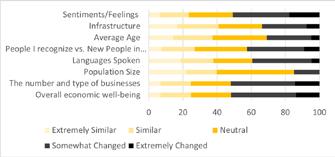
Research in migration suggests that stressors, such as prospects for livelihoods, su ciency of public services, and safety, create fertile ground for people to ultimately decide to migrate from their communities and countries. Unsurprisingly, nearly all of Ukrainians reported having at least one stressor in their life. The majority cited safety and security as a topic of ongoing conversations with friends and neighbors, the second most common concern was the oncoming winter (See Figure 2).
Figure 2
Stressors Talked about with Neighbors/ Friends
Topic of Conversation Percent
Safety or security due to war 73
Concerns about oncoming winter 52
Tight labor market/poor job opportunities 33
Disruption of education for children 29
Food insecurity 17
Housing issues 13
Di culties in transportation 13
Finding basic health and/or hygiene supplies 9
Air pollution, trash/waste disposal or other environmental concerns 8
Disruption of education for myself or other adults 7
None of the above 6
50 / Service Contractor / 2022 Professional Services Council
CIDC: THOUGHT LEADERSHIP COMPENDIUM
23
COMPENDIUM
These stressors compound economic fragility among respondents (Figure 3). A quarter of respondents had insu cient income for living expenses and 52% faced uncertainty regarding how long these income sources will pay for living expenses. Very few families reported being able to rely on outside support to make ends meet. While 35 percent were currently working, those seeking jobs were not very optimistic about finding work in their localities.
Figure 3
Financial Security measured as Ability to Pay for Living Expenses, Share of Respondents

Nearly one-fifth (17%) of respondents were internally displaced, with a majority being from East and South. Most (72%) of internally displaced had strong intentions to return to their hometowns eventually. Families cited continued conflict and instability as the main impediments to returning to their hometowns (Figure 4). Notably, very few people cited housing, work or resources/logistics for travel as an impediment to return.
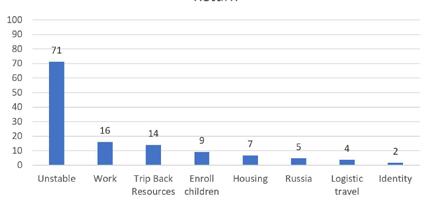
Figure 4
Share Reporting Each Item as an Impediment to Return
Professional Services Council Service Contractor / 2022 / 51
CIDC: THOUGHT LEADERSHIP
A significant number of respondents were internally displaced, but determined to return to their hometowns within Ukraine
Overall, there seemed to be a sense of social cohesion within communities across all respondents. Most of all respondents, both long-term residents and internally displaced individuals, felt that everyone did their share to keep their communities safe and clean. Most respondents felt that public services were both adequate and equitably accessible to everyone in their communities. Two-thirds felt a shared responsibility for sustaining their communities’ public services and safety. A majority (56%) of internally displaced respondents indicated feeling comfortable in their host communities. Forty percent reported having made new friends in their new residences. Moreover, there was widespread commitment to actively contribute to local communities’ reconstruction (Figure 5). Most (72%) expressed being personally prepared to lend a hand in their community’s reconstruction. Most respondents felt that their local government representatives both had the authority to enact the policies and programs needed to rebuild and had confidence in their local representatives’ ability to do so.
Figure 5
Sentiments and Agency for the Future of Ukraine and Local Communities

52 / Service Contractor / 2022 Professional Services Council
Friction at the community level appears to be minimal for now; respondents share their commitment to the tasks ahead and optimism. Some anticipate problems in the future.
25 CIDC: THOUGHT LEADERSHIP COMPENDIUM
While respondents indicated a shared sense of responsibility and high levels of social cohesion, other questions indicate that issues may arise. For those who were permanent residents in their homes, most (66%) reported having a significant internally displaced population in their communities. Among respondents reporting a significant internally displaced population in their communities, a small portion (12%) anticipated significant problems in the long-term if internally displaced populations permanently relocated to their communities. A somewhat larger share (31%) anticipated some problems if internally displaced populations permanently relocated to their communities. As uncertainty continues regarding how long internally displaced populations may stay within host communities, Ukrainians would be well-served to consider ways to facilitate social cohesion within communities with large internally displaced populations now.
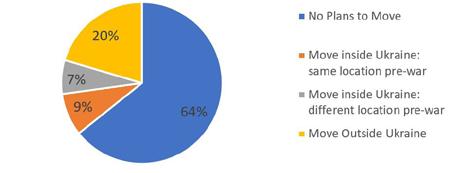
While most intend to stay in Ukraine for the foreseeable future, a significant minority reports disposition to migrate
Eighty percent of respondents expected to remain inside Ukraine in the foreseeable future (Figure 6). Safety was the main concern for potential relocation among respondents, with 31 percent having jobs factoring into their relocation decisions. Our survey also gauged respondents’ overall optimism about their futures, the future of Ukraine and their capacity to support rebuilding. Those who were more optimistic were less likely to intending to move from their current location, suggesting that people’s perception of hope and optimism is important in mitigating outward migration from Ukraine. Beyond material improvements, development work would be well served to attune to people’s psychological needs and perceptions of optimism.
Notably, internally displaced populations may be at higher risk for leaving Ukraine if they are unable to return to their hometowns. A very small share of displaced respondents intended to live in their host communities permanently. Just a fifth (20%) reported having found a job. Just 30 percent were optimistic about having a prosperous future in their host communities. Fortifying local economies of host communities might be crucial to prevent these populations from relocating outside Ukraine in search of work.
Figure6
Moving Plans, Share of Respondents, Within Ukraine and Abroad
Professional Services Council Service Contractor / 2022 / 53
CIDC: THOUGHT LEADERSHIP
COMPENDIUM
Looking Ahead: addressing immediate preoccupations and laying critical foundations
Brave families throughout Ukraine are forging ahead with their lives despite ongoing instability and active conflict. While the vast majority of respondents do not intend to leave Ukraine, a significant minority—representing a considerable number of individuals—in our study considered migrating. Understandably, safety and security by far remain the principal concerns of those consulted, provoking at-risk populations to relocate—and preventing refugees abroad from returning Ukraine. There are clear signs of financial struggle among individuals who participated in our study, with many reporting marked financial insecurity at present and financial uncertainty looking forward. Unemployment reported by respondents is significant if not alarming, and job seekers feel relatively pessimistic about finding work. Notably, the oncoming winter is a new development of considerable concern among respondents, perhaps reflecting extensive media coverage of the issue and the hands-on recognition of the levels of destruction;5 among other things, Ukrainians are openly concerned that Russian forces may attempt to destabilize major cities by attacking centralized heating systems. If this were to happen, a second wave of migration of Ukrainians escaping frigid temperatures may be inevitable if unmitigated.
Millions of Ukrainians who fled the country have found their way back home, mostly to their hometowns demonstrating relative safety. In contrast, within our sample of Ukrainians in Ukraine, the volume of internally displaced populations was very significant. The makeup of communities is reported to have changed in several dimensions. The generalized sentiment, however, is that, owing to remarkable empathy towards fellow Ukrainians in need, internally displaced populations consulted are satisfactorily meeting immediate needs in host communities. Importantly, however, families who are internally displaced don’t see themselves as permanent residents and visibly prioritize their return to communities of origin. In this respect, expectations must be managed for both—longterm residents and internally displaced populations—and vision, viability, and incentives for more permanent arrangements must be framed. In the meantime, intentional e orts to sustain and enrich existing community cohesion ought to be considered within plans for recovery.
Ukrainians’ commitment to rebuilding and sense of shared responsibility are invaluable and unassailable assets in meeting the nation’s immense development challenges. While security concerns remain determinant, Ukrainians seem ready for what’s to come. Ukrainians consulted feel the economy will jump back to pre-war levels, albeit with varying timelines. By and large and importantly, survey respondents also endorsed the capacity of local authorities to chart a way forward. Despite the devastation, the war may develop in unexpectedly positive directions and new opportunities may emerge.
Ukrainians need a comforting vision and an optimistic narrative to remain in place and return in high numbers when security permits. It is increasingly evident that Ukrainians will return in high numbers when security permits and Ukrainians are eager and able to rebuild their nation. More than operational capacity support, international actors would be well advised to support Ukrainians’ shared vision, their sense of optimism and their agency in rebuilding their local economies and communities.
54 / Service Contractor / 2022 Professional Services Council
CIDC: THOUGHT LEADERSHIP COMPENDIUM
Endnotes
1.“Ukraine: Apparent War Crimes in Russia-Controlled Areas.” Human Rights Watch, October 11, 2022. https://www.hrw.org/news/2022/04/03/ukraine-apparentwar-crimes-russia-controlled-areas.
2.“Ukraine Situation Flash Update #28.” UNHCR Operational Data Portal (ODP), n.d. https://data.unhcr.org/en/documents/details/95314.
3.Ibid
4. The survey was a random sample. After stratifying for regions, invitations were sent randomly to 19,788 with 1,504 responses between July 15 to 20th, for an 8% response rate.
5.Mak, Tim. “Ukrainians Prep for Winter. If Russia Hits Heating Systems, Cities Will Freeze.” NPR. NPR, September 6, 2022. https://www.npr. org/2022/09/06/1121201345/ukrainians-prep-for-winter-if-russia-hits-heating-systems-cities-will-freeze.
About Creative
Creative Associates International works with underserved communities by sharing expertise and experience in education, elections, economic growth, citizen security, governance and transitions from conflict to peace.
Based in Chevy Chase, Creative has active projects in nearly 30 countries. Since 1977, it has worked in nearly 90 countries and on almost every continent. Recognized for its ability to work rapidly, flexibly and e ectively in conflict-a ected environments, Creative is committed to generating long-term sustainable solutions to complex development problems.
Professional Services Council Service Contractor / 2022 / 55 4445 Willard Avenue Suite 400 Chevy Chase, Maryland 20815 CreativeAssociatesInternational.com +202.966.5804 Creative Associates International Communications@CreativeDC.com Connect with us!
28 CIDC: THOUGHT LEADERSHIP COMPENDIUM
Facilitating ocal olutions to omplex hallenges



56 / Service Contractor / 2022 Professional Services Council
29 CIDC: THOUGHT LEADERSHIP COMPENDIUM
ICF: Facilitating local solutions to complex challenges









Professional Services Council Service Contractor / 2022 / 57
REPORT October 2022 CIDC: THOUGHT LEADERSHIP COMPENDIUM
ICF: Facilitating local solutions to complex challenges

Introduction
As the COVID-19 pandemic spiraled out of control globally, we all saw the symptoms of lack of coordination among governments at national and local levels, businesses, and civil society: Shortages in critical supplies, depletion of national stockpiles, seesawing policy responses, and a ballooning problem of mistrust in public health. Education systems suffered as schools shut down, countries with already fragile economies were hit hard as businesses ceased to operate and people lost jobs, and the impact of natural disasters and civil unrest were further amplified as communities and families struggled to remain resilient.
The scale and complexity of these challenges seem daunting, but there are important success stories that show the positive impact of a coordinated approach to large-scale problems tapping the expertise and resources of industry and social sectors and stakeholders. Consider malaria control: In 2020, 26 countries reported fewer than 100 indigenous cases of the disease, up from six countries in 2000. Progress has been achieved through internationally coordinated aid, joint disease monitoring across sectors, and new technologies from the private sector, including vaccines and anti-malarial drugs.
Poverty, climate change, food insecurity, water scarcity, antimicrobial resistance, and emerging pandemic threats are among the planet’s gravest threats in the short and long term. Like malaria, they are complex problems requiring multisectoral solutions that are data-driven, utilize innovative technologies, and are grounded in the local context and requirements. ICF addresses these challenges by engaging an array of experts who are closest to the issue at hand in order to build sustainable solutions.
Engaging local expertise in data collection, analysis, and use
The global community has undertaken many efforts to collect and disseminate data to inform programmatic and policy decisions.
In the health sector, USAID’s Demographic and Health Survey (DHS) Program, which ICF has led since 1984, is one of the greatest examples of a global public good that has established a strong evidence base for national planning efforts, policy
decisions, innovative research, and programmatic adjustments and planning. The DHS Program has earned a worldwide reputation for collecting and disseminating accurate, nationally representative data by working in partnership with host country implementation agencies to ensure local ownership. Global donors and host countries share the cost and labor of survey design, data collection, analysis, and dissemination. The DHS Program also strengthens local skills in all areas of design, implementation, and analysis through on-the-job mentoring, classroom training, curriculum development, and eLearning courses.
Neha Wadekar, an independent journalist based in Nairobi, Kenya, says that DHS data are instrumental in her work as a journalist and storyteller. Covering countries across Africa, she often encounters a critical lack of reliable data. For a project in northern Kenya, she used DHS Program data in her stories about child marriage for TIME Magazine and female genital cutting for VICE Media. DHS Program data fill significant information gaps on many important issues, allowing researchers, reporters, and policymakers to have years of consecutive information and numbers to be able to identify trends and changes in key areas.

DHS data sets are publicly available at no cost through innovative tools like STATcompiler, the DHS mobile app, DHS API, spatial data, the DHS user forum, raw datasets, GitHub, the DHS Program blog, eLearning courses and workshops, YouTube tutorials, and multiple publications that include final reports, factsheets, infographics, analysis reports, briefs, and more.
The DHS Program collects data relevant to many challenges beyond health, including household wealth, energy use, education, employment, mass media exposure, and domestic
58 / Service Contractor / 2022 Professional Services Council
© ICF 2022 CIDC: THOUGHT LEADERSHIP COMPENDIUM
ICF: Facilitating local solutions to complex challenges
violence. Researchers, project implementers, clinicians, policymakers, journalists, academics, and others use DHS data to inform efforts in multiple sectors. And because the data is considered a global public good, its uses have been far reaching and informed important global discussions. For example, in March 2021, the Government of Pakistan cited DHS data to support its decision to roll out an education stipend program for secondary education under Ehsaas—a government social safety and poverty alleviation program launched in 2019. Steering Committee Chair Dr. Sania Nishtar issued a statement in the publication Nation saying, “Currently, there are 18.7 million out-of-school children, in the age group 6 to 16, in the country. Further, there is a high chance that COVID-19 induced livelihood losses have caused over a million more dropouts. According to the Demographic and Health Survey 2017, the dropout rate is highest for the poorest two quintiles in secondary education.”
Quality data collection that has strong buy-in from all local stakeholders will maximize the value of that data for local and global actors working on cross-sectoral problems. Ensuring local ownership and support for all aspects of data collection is an investment worth making.
Power says that dealing with a pandemic, climate change, or other major challenge requires being more responsive to the requests of our partners in the countries where we work. This kind of approach is not entirely new, but it underscores a shift in collaboration and financing from globally to locally led partnerships. Local organizations are critical to helping achieve greater buy-in as well as sustainability of efforts. At the same time, governments, businesses, and civil society are also increasingly recognizing the need to engage affected communities and both varied and non-traditional partners to advance global health and economic welfare. Civil society plays a critical role as a trusted source of information, data, and essential services. It also defends human rights and seeks to hold governments and businesses accountable for their actions.
Successful multisectoral collaboration rarely happens without intentional effort and design. There are many reasons that sectors don’t work together: Natural tensions exist when there is a mismatch between sectors in terms of power and resources, economic externalities exist, or there are competing objectives such as extractive activities that may benefit economic goals but harm community health and welfare. But with intentional design and co-creation, these obstacles can be overcome to foster the inclusion of stakeholders across economic and social spheres and professional fields, to the mutual benefit of all sectors and, ultimately, the people they serve.
USAID Administrator Samantha Power’s new vision for global development emphasizes localization, which engages affected country stakeholders. Her vision places “local communities in the lead to either co-design a project, set priorities, drive implementation, or evaluate the impact of our programs.”
Engaging the private sector can be key to a global development project’s success. For example, ICF leads a consortium of partners on the USAID-funded Infectious Disease Detection and Surveillance (IDDS) project. Since May 2018, IDDS has strengthened health systems in more than 20 countries in Africa and Asia to detect, track, and rapidly respond to infectious diseases and drug-resistant infections. In India, IDDS engaged the private sector in the Hisar district of Haryana state to tackle the long wait times for patients’ tuberculosis (TB) results. The overburdened public sector laboratory system often took weeks to return TB results to clinicians, during which time sick patients were likely exposing others in their community to the illness. Due to the long delays, many patients “dropped out” before ever receiving treatment, and even those receiving treatment could wait months before clinicians found out whether their patients’ TB infections were resistant to their prescribed treatment. IDDS launched a “one-stop” model in Hisar in 2022 by contracting a private-sector laboratory to expand TB diagnostic care and provide end-to-end services from onetime specimen collection to delivering test results within stipulated faster turnaround times. This helped facilitate quicker treatment initiation and prevent the spread of TB in the community. Thanks to the new model, the proportion of TB diagnoses that have been confirmed with a laboratory test for more accurate diagnosis rose from 44% in 2021 to 84% in August 2022. Hisar now ranks second for universal drug susceptibility testing for the detection of rifampicin resistance in Haryana state, up from 10th before the implementation of the model.
Professional Services Council Service Contractor / 2022 / 59
Actively engage the right stakeholders early in design and be open to innovative solutions.
CIDC: THOUGHT LEADERSHIP COMPENDIUM
Engaging potential partners across sectors and down to the local level helps achieve sustainable results—and address global health threats. In Vietnam, Indonesia, and Uganda, the IDDS project has helped accelerated disease detection and control by coordinating the human, animal, and environmental health sectors—a One Health approach 70% percent of new or emerging infectious diseases in humans are zoonotic, i.e., come from animals. To contain an outbreak of a zoonotic disease, public health officials, veterinarians, and others need to identify threats and coordinate their responses from national to local levels and across disciplines. In Indonesia, IDDS partnered with national and local organizations to strengthen a health surveillance information system that links the public, animal, and wildlife health sectors. Likewise, IDDS worked with Vietnam’s Department of Health and regional and provincial health agencies to bolster an online disease reporting system for animal and zoonotic diseases.
IDDS helped Uganda make its One Health approach local by creating teams of health experts in districts prone to zoonotic disease outbreaks and where many human and veterinary health officials had previously never spoken to each other. These district-level One Health teams now meet regularly to share data, prepare for future disease outbreaks, and, when an outbreak occurs, coordinate their response to prevent the outbreak from spreading. The IDDS project also expanded laboratory testing capacity from central to regional sites in Uganda. It regionally piloted an electronic data entry tool that speeds up data collection and prevents errors, while helping national officials aggregate and analyze data to make it easier to spot disease outbreaks and mobilize resources.

Facilitating local ownership of technology solutions

Tackling the climate change challenge in the power sector requires a similar approach: Engaging key stakeholders, developing critical data, and leveraging technology to forge sustainable solutions. Electricity—increasing its access, reducing its environmental impacts, and managing its costs— has become a universal development priority, affecting every sector of society, and reducing power sector emissions is a new imperative since all nations pledged to do so in the 2015 Paris Agreement.
Reliable, affordable access to electricity is a fundamental development need in every sector: Health care, for example, requires power supplies for refrigeration, medical equipment, and other critical care needs. But global power sector greenhouse gas emissions rose sharply in 2021, highlighting the multiple needs of sustaining power sector growth and reducing emissions while increasing energy system resilience to climate change impacts. Meeting these needs calls for a more integrated, long-term process for planning and operating power systems in the developing world. That’s why USAID funded the Ghana Integrated Resource and Resiliency Planning (IRRP) project to meet these needs.
ICF led the Ghana IRRP’s technical work and coordinated its extensive stakeholder process. People were the key to the IRRP’s success in producing a consensus Power Sector Master Plan that won the support of governments, electricity organizations, and other stakeholders across Ghana. People were essential to the project from the beginning, especially in building the project team—which ICF recruited from Ghana’s power sector institutions and civil society organizations—and in populating the Steering Committee, Technical Committee, and a host of organizations who provided less formal but critical input and consultation.
60 / Service Contractor / 2022 Professional Services Council icf.com
© ICF 2022
ICF: Facilitating local solutions to complex challenges
USAID and IDDS staff meet with hisar district staff of the national tb elimination program to discuss the one-stop model. Photo by IDDS
Veterinary officials demonstrate how a blood specimen is collected from a cow in a rural Ugandan district. Photo by IDDS
CIDC: THOUGHT LEADERSHIP COMPENDIUM
ICF: Facilitating local solutions to complex challenges


Figure 1. USAID Ghana IRRP A Case Study for Future Activity Design
The IRRP team’s people were also critical to collecting and analyzing essential data. Through a team comprised of Ghanaian professionals with deep experience in the power sector, IRRP was able to quickly identify and gather data from key sources. This approach was especially helpful in developing the power demand forecasts that drove much of the IRRP process: The team collected and compiled earlier forecasts, unpacking their inputs and assumptions, and converged on a robust methodology that made best use of available data and modeling tools. Other key technology and data options in the IRRP arena include remote sensing and control technologies operated via cellular or Wi-Fi communications systems to make power grids “smarter,” and leveraging the “Internet of Things” opportunities enabled by Internet Protocol and related interoperability standards. IRRP planners also use standardized methodologies such as the USAID CLEER Tool to measure the emissions impacts of various energy technologies.
Conclusion
The global crises affecting all of us, from COVID-19, supply chain disruptions, and climate change-induced natural disasters, to famine and food insecurity, have highlighted something we’ve long understood but perhaps lost sight of as we worked in our sectoral silos across health, climate, education, energy, and others: These crises, and many other social, economic, and political challenges, have roots in multiple sectors. As these challenges continue to complexify, local leaders and stakeholders across sectors must drive the solutions and own the data and technologies needed to inform and support their decisions.
Professional Services Council Service Contractor / 2022 / 61 icf.com
CIDC: THOUGHT LEADERSHIP COMPENDIUM
Photo Credit: User:ZSM - Wikimedia Commons
ICF: Facilitating local solutions to complex challenges






























About ICF ICF (NASDAQ:ICFI) is a global consulting services company with more than 8,000 specialized experts, but we are not typical consultants. At ICF, business analysts and policy specialists work together with digital strategists, data scientists, and creatives. Across more than 100 countries and cultures, we engage local institutions, improve institutional capacity, and strengthen systems through participation, collaboration, and flexibility. Since 1969, publicand private-sector clients have worked with ICF to navigate change and shape the future. Learn more at icf.com.

62 / Service Contractor / 2022 Professional Services Council
©
ICF 2022
CIDC: THOUGHT LEADERSHIP COMPENDIUM
In the Fog of War: Ukraine’s Fight Against Corruption in the Midst of Russia’s Invasion



Professional Services Council Service Contractor / 2022 / 63
36 CIDC: THOUGHT LEADERSHIP COMPENDIUM
In the Fog of War: Ukraine’s Fight Against Corruption in the Midst of Russia’s Invasion
Two years ago, many Americans could not have located Ukraine on a map. Today, names and images of small Ukrainian towns, progress and setbacks on the battlefield, and personal stories of displaced and devastated Ukrainian families are featured daily across newspapers, podcasts, social media, and televisions across America. Beside them are the dramatic stories of resilience and bravery by countless Ukrainians, providing glimmers of hope to a global audience.
Alongside the military battles, Ukraine continues to wage a less visible battle—a battle against corruption, which dates to the 2014 Revolution of Dignity. Like everything else in Ukraine, that conflict has been forced to adapt to radically and constantly evolving and uncertain circumstances. While it might be tempting to shelve this quiet battle for another day, Ukraine—with the support of the U.S. Agency for International Development (USAID)—has doubled down on this fight as well.
This article—written from the perspective of experts at MSI, A Tetra Tech Company, and USAID’s implementing partner for supporting anti-corruption efforts in Ukraine for more than 25 years1—explores why and how they have decided to do this despite uncertainty about the war and how the country will be rebuilt. It is written from Tetra Tech’s perspective as a third party working to support a range of Ukrainian anti-corruption organizations under the auspices of the USAID-funded project, Support to Anti-Corruption Champion Institutions2 (SACCI).

The Role of Anti-Corruption in Ukraine Before, During and After the War
Ukraine’s fight against corruption, and international donor support for that effort, started well before the current conflict. It began against a backdrop of longstanding and pervasive corruption that placed the country near the bottom of virtually every index. Despite these considerable efforts and some notable progress prior to the war, Ukraine was still ranked as Europe’s third most corrupt country by Transparency International3

When Russia invaded Ukraine in February of 2022, both the Ukrainian and the U.S. governments quickly recognized that unprecedented quantities of military and humanitarian aid were likely to flow into the country from a variety of official and less official sources for an indeterminant period, and that this would likely be followed by a lengthy period of reconstruction. 1 https://www.thinglink.com/scene/1050024436536705027 2

64 / Service Contractor / 2022 Professional Services Council
https://www.msiworldwide.com/projects/preserving-gains-against-corruption-ukraine-during-wartime 3 https://www.transparency.org/en/cpi/2021
Larry Cooley, Phyllis Dininio, Eka Tkeshelashvili, Ellen Yount
CIDC: THOUGHT LEADERSHIP COMPENDIUM
COMPENDIUM
They also understood that proper management of these funds would, at some point, shape the willingness of these and other partners—including donors, international development institutions, and the private sector—to support Ukraine financially4. And both governments realized that any practices they instituted needed to be adapted to a context where nothing was predictable, discretion at the field level was essential, and excess bureaucracy was a luxury they could not afford.
When war broke out, USAID’s decision to expand rather than curtail its support for Ukraine’s fight against corruption reflected an understanding by USAID’s leadership of these realities and the need for anti-corruption efforts to occupy a prominent position alongside other USAID priorities, including the provision of housing and helping Ukraine to meet its energy needs in the face of Russia’s attacks on numerous energy grids.
Since 2017, the USAID SACCI team has worked closely with government agencies including the National Agency for the Prevention of Corruption (NACP), the Anti-Corruption Policy Committee of the Parliament, the Ministry of Health, and the State Property Fund of Ukraine; and with civil society organizations, including Transparency International Ukraine, the Association of Legal Clinics of Ukraine, White Collar Hundred (WCH), and Slidtstvo. With a strong team of Ukrainian and regional experts in place, and an established foundation of trust with these organizations and with USAID, SACCI provided atypical levels of flexibility to pivot, and pivot again, as needed to meet new and emerging needs amidst the war.
This foundation of trust-based relationships allowed USAID and Tetra Tech to amend civil society organizations’ (CSO) scope agreements quickly to incorporate new functions such as:
• Helping document damage to civilian objects;
• Collecting stories of impact of the Russian invasion on civilians; and
• Communicating about developments on the ground.
It also permitted the NACP to redirect attention to providing access to databases for:
• Tracing assets of individuals connected to the war effort;
• Assessing corruption risks in the delivery of humanitarian aid; and
• Providing corruption risk mitigation recommendations.
By late March, Ukrainian anti-corruption agencies and champions had begun to find their place in this new context. They focused on enhancing accountability in the delivery of humanitarian aid, as well as developing practical measures to augment anti-corruption procedures that were, of necessity, loosened in the war’s earliest days. Building on relationships established through prior engagement with capable and trusted Ukrainian partners, USAID and Tetra Tech were able to make these changes with unusual pace and flexibility even when obliged to work remotely from the United States, Poland, and Georgia. This took place despite the fact that Ukrainian team members, like others in the country, were enduring unexpected missile attacks, energy and food shortages, and the daily emotional and mental distresses of displaced colleagues, friends, and families.
In addition to the development and implementation of systemic safeguards, Ukrainian and USAID officials and the SACCI team identified the need to bolster rather than walk away from the array of civil society organizations and protections that had been a focal point for anti-corruption efforts prior to the war. Specific activities focused on ensuring the continuity of key organizations and initiatives, including Transparency International Ukraine, the Institute of Applied Humanitarian Research (IAHR), and the Association of Legal Clinics. While investigative journalism moved its primary focus to documenting war crimes and damage to civilian targets, and whistleblower activities shifted to focus on war-related issues, both continued to receive active support from the project.
4 From a U.S. perspective, we already begin to see these debates unfolding in the U.S. Congress – and in some cases, becoming the subject of campaign debates.
Professional Services Council Service Contractor / 2022 / 65
CIDC: THOUGHT LEADERSHIP
38
For example, in addition to its anti-corruption investigations, the WCH NGO, supported by SACCI, began documenting the war’s toll on civilians and civilian infrastructure. SACCI also extended its grant to Slidstvo.info for investigative journalism to incorporate reporting from the frontline on local efforts to unite communities and help people in wartime.
In addition to supporting these strategic shifts, USAID encouraged SACCI to help counterparts manage a variety of time-sensitive, essential administrative tasks such as securing databases and essential registries. This included the NACP’s registry of income/asset declarations of public officials, political parties’ financing reports, and the registry of corrupt officials. We helped these organizations store this critical data in the cloud, and then make it operational so that staff could continue to work with the data and registries. USAID also authorized us to support other practical accommodations, which included securing data on servers, ensuring redundancy, and enabling Ukrainian staff to work remotely. And when the IAHR office in Kharkiv was destroyed, SACCI purchased laptops, Wi-Fi routers, and SSD devices for the organization.
Even amidst the continuing destruction, many in Ukraine have begun to plan for the massive rebuilding effort that lies ahead and to anticipate the country’s eventual entry into the EU. A recent editorial in the Washington Post5 stated the proposition in stark terms:
…the reconstruction of Ukraine will depend on more than cash and concrete, although heroic amounts of both are needed. Ultimately its fate will turn on a transformation of mind-set and governance in a nation notorious for oligarchs and endemic corruption. Even before the shooting stops, the country must launch a durable, ironclad, transparent project to transform ministries, markets, courts, businesses and institutions, raising them to Western democratic and free-market standards.
Discussions are well underway on approaches to coordinating and managing financial support through a special Trust Fund and a Ukrainian Marshall Plan. Ukraine presented its own vision for rebuilding at the Ukraine Recovery Conference held in Lugano, Switzerland in July of this year. In mid-October, top Ukrainian and international officials took part in the G7’s International Expert Conference on Recovery, Reconstruction and Modernization of Ukraine, hosted in Berlin, Germany. Donors and international development institutions at the Berlin conference reaffirmed that they are united in their commitment to Ukraine’s victory and short- and long-term recovery needs, including ensuring accountability and transparency.
Echoing this sentiment, a recent Brookings blog by Josh Rudolph and Norman Eisen framed the issues this way6:
Given how valiantly Ukrainians are defending the front lines of the free world, a morally and politically difficult job will fall to the leaders of the United States and the European Union: They will have to insist on sending Ukraine hundreds of billions of dollars for recovery and reconstruction only if the aid architecture and reform agenda aggressively prioritize anti-corruption. Protecting aid money from corruption and pressing forward with reform in Kyiv is essential for Ukrainian sovereignty, the country’s EU accession, and the integrity of Western tax dollars. Strong anti-corruption commitments and performance are key to Ukraine emerging from this devastating war with a modern democracy and fair economy worthy of such historic sacrifice.
In recognition of these realities, USAID prioritized SACCI support to the Government of Ukraine in embedding efforts to limit corrupt and promote transparency into emerging reconstruction plans. And when prominent Ukrainian CSOs united into an informal coalition called RISE Ukraine to support the recovery of Ukraine and ensure its transparency and accountability, SACCI was given the green light to support members of that coalition and to support the operations of the coalition.
5 Build Ukraine back better, Washington Post, October 21, 2022; page A22.
6 Ukrainian reconstruction funding must be tied to anti-corruption, Josh Rudolph and Norman Eisen, The Brookings Institution, October 24, 2022.
66 / Service Contractor / 2022 Professional Services Council
CIDC: THOUGHT LEADERSHIP COMPENDIUM
39
Emerging Lessons for Ukraine and Beyond
Russia’s war against Ukraine and its people is unique in several ways, but we believe there are lessons to be learned for anti-corruption programming in other conflict settings, including:
1. The temptation to subordinate or defer anti-corruption efforts can and should be resisted lest perceived abuses directly undermine medium-term support for the war effort and subsequent reconstruction.
2. Safeguards need to focus on wartime priorities and can be designed in ways that do not impede or delay essential action.
3. Donor support for instituting anti-corruption safeguards during active conflict is more feasible where prior investments have established strong local institutions and strong interpersonal relationships.
4. Civil society activities focused on transparency and accountability are essential complements to government action.
5. Enhanced flexibility and delegation of authority are indispensable and require both active support from donor agency leaders and trusted local teams.
As the life and death struggle for the sovereignty and future of Ukraine continues, these efforts to fight corruption represent a second, less visible, battlefront in the fight for Ukraine’s future. As a longtime partner of USAID/Ukraine and of Ukraine’s anti-corruption champions, Tetra Tech is committed to remaining on the frontlines.
About the Authors

Larry Cooley is the Founder and President Emeritus of MSI, A Tetra Tech Company. He is an elected Fellow and board member of the US National Academy of Public Administration and prior chair of its Standing Panel on International Affairs, and he serves as current Board Chair of the Society for International Development and of World Learning.
Phyllis Dininio is the Chief of Party for the Countering Transnational Corruption Grand Challenge funded by USAID and has led anti-corruption efforts at MSI, A Tetra Tech Company, USAID, the State Department, and the World Bank.
Eka Tkeshelashvili is the Chief of Party for the USAID-funded Support to Anti-Corruption Champion Institutions project and is an active member of the Advisory Committee on Voluntary Foreign Aid (ACVFA). Eka also led the EU Anti-Corruption Initiative in Ukraine and was the Former Minister of Justice, Foreign Affairs and Prosecutor General of Georgia.
Ellen Yount is a Vice President with MSI, A Tetra Tech Company, currently based in Warsaw, Poland to coordinate Tetra Tech’s contributions to Ukraine reconstruction and recovery.
Learn more at tetratech.com/intdev and msiworldwide.com

Professional Services Council Service Contractor / 2022 / 67 CIDC: THOUGHT LEADERSHIP
COMPENDIUM
4401 Wilson Blvd., Suite 1110 Arlington, VA 22203
Professional Services Council















































 BY:
BY:







 By Tetyana Dudka, Senior Vice President, Europe and Eurasia Division, and Garron M. Hansen, Senior Vice President, West Africa and Haiti Division, both of Chemonics International
By Tetyana Dudka, Senior Vice President, Europe and Eurasia Division, and Garron M. Hansen, Senior Vice President, West Africa and Haiti Division, both of Chemonics International

























































